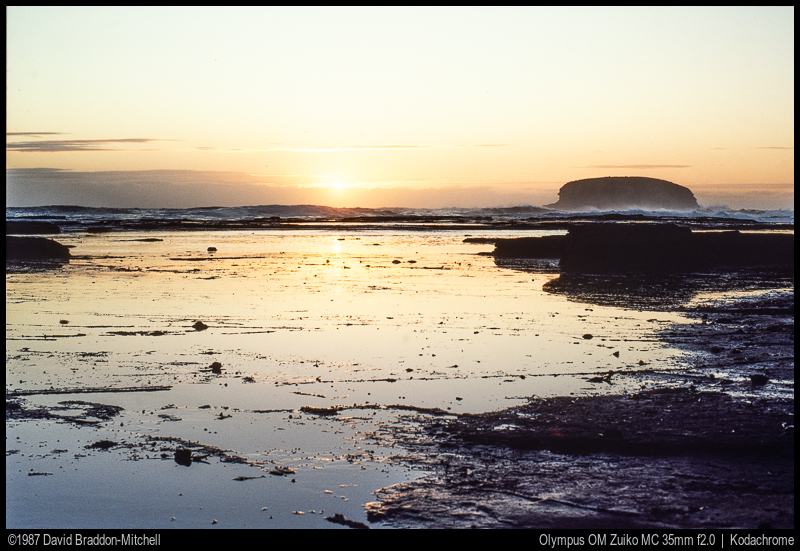
Yoshihisa Maitani’s Olympus OM system was a remarkable achievement, with beautifully engineered smaller bodies and exquisite small lenses, often as good or better than larger lenses from the competition. They are all nicely engineered and a joy to use. This makes them very tempting options for someone who wants to explore them on a modern full frame camera, or for someone who wants to experiment with film. I was an OM system user back in the days of film, so you’ll see a few samples from me that are from OM film cameras, as well as digital. In this guide Juriaan, Phillip and I will take you through the lenses with comments about how they perform, and whether they make sense adapted to Sony full frame digital cameras.
Many of the samples are film era images taken from my (David’s) personal archives. We don’t therefore pretend that they illustrate the technical qualities of the lenses, but they do give you an idea of the creative possibilities of them.
Except for a few late era lenses, they won’t resolve quite as well as the best expensive modern lenses, or be as as contrasty as the latest Zeiss or GM glass. But many are close and nonetheless extremely good, and others have a look which we sometimes enjoy as an alternative to the near perfection of some recent glass.
Contents
- Some factors to consider in choosing classic lenses
- A little history of OM lenses.
- Zuiko Prime Lenses: A Chart
- Lenses in the guide
- Olympus Zuiko Fisheyes and 18mm.
- Olympus Zuiko 21mm f3.5
- Olympus OM Zuiko MC 24mm f2.8 (Phillip)
- Olympus OM Zuiko 24mm f2.8
- The Fast Super Wides: 2/21 and 2/24
- Olympus Zuiko MC 28mm f2
- Olympus G.Zuiko 28mm f3.5
- Olympus OM Zuiko 28mm f2.8
- Olympus OM Zuiko MC 35mm f2
- Olympus OM Zuiko 35mm f2
- Olympus OM Zuiko 35mm f2.8
- Olympus OM Zuiko SHIFT 35mm f2.8
- Olympus Zuiko 50mm f1.2
- Olympus G.Zuiko 50mm f1.4
- Olympus Zuiko 50mm f1.4
- Olympus F.Zuiko 50mm f/1.8
- Olympus Zuiko 50mm f1.8
- Olympus Zuiko 50mm f2 Macro
- Olympus Zuiko MC 50mm f3.5 Macro
- Olympus G.Zuiko 55mm f1.2
- Olympus F.Zuiko 85mm f2.0
- Olympus Zuiko 85mm f2.0
- Olympus OM Zuiko 90mm f2
- Olympus OM E.Zuiko 100mm f2.8
- Olympus OM Zuiko 100mm f2.8 (Phillip)
- Olympus OM 100mm f2 (Phillip)
- Olympus OM Zuiko 135mm f3.5
- Olympus Zuiko MC 135mm f2.8
- Olympus Zuiko MC 200mm f4
- Olympus Zuiko 200mm f5
- Olympus Zuiko 180mm f2 (Bastian)
- Olympus Zuiko 250mm f2 (Bastian)
- Olympus Zuiko 350mm f2.8 (Bastian)
- Olympus Zuiko Old-Style Telephoto lenses
- Closing Remarks
- Other Articles
- Support Us
Some factors to consider in choosing classic lenses
There are many factors you need to take into account when buying older lenses, all of which are related to the reason you are doing it. You might want to save money, you might be sentimentally attached to an old brand, you might like the unique look some of these optics offer, you might be a collector at heart. Let’s think about how getting clear about your motivations might affect the decision you make.
1. Are you basically looking for a high resolutions manual lens for a good price?
This is a good reason for buying classic glass. But you need to be a bit careful. There are a number of OM lenses which are competitive with the best modern glass – the 2/50, 2/90 and 2/100 as well as the superteles spring to mind. But they are very expensive, so much so that you are probably better off, if performance is all you care about and you want manual focus, spending a little more for a modern CV or Zeiss lens. Of course those lenses have other features that you might care about as well.
The money saving motivation really applies mostly to less expensive lenses some of which are nonetheless still very sharp.
2. Are you looking to fill a gap that’s not currently filled?
Sometimes there are lenses in a genre for which there is no modern equivalent yet. There are no modern smaller medium tele lenses. If you want a compact tele for occasional use, then an adapted OM might fit the bill. They are mostly pretty good (though when there are finally modern ones they will be better).
3. Are you looking for the “look” of an older lens?
In this case you will care less about the absolute resolution and more about the rendering, so long as performance is decent. Some people may even prefer the older versions with single coating for artistic flare and so forth.
4. Let’s be honest. Are you collecting?
Using older lenses can be kind of an excuse to collect. Nothing wrong with that, but probably it’s a good idea to be clear what your motivation is! If you are collecting you’ll care more about condition. If you are just using the lens, then a cosmetically fair sample with clean glass will save you a lot of money.
A little history of OM lenses.
OM lenses when through a number of changes over the years. The earliest change was merely cosmetic: when the M-System became the OM system, because of trademark issues with Leica. But later changes sometimes coincided with changes in the optics and coatings. It’s pretty clear that Olympus updated the optical design at least once over the OM era for many of these lenses, as well as having at least three generations of coatings. Sometimes the optical changes are obvious: the number of elements or groups changes, so it must have been redesigned. But there are other optics that must also have been redesigned if you pay close attention, because the overall size of the lens has altered enough that it couldn’t be exactly the same formulation. It’s hard to be sure exactly when in the production run this happens though. Unlike some makers, Olympus never advertised Mk II!
The coatings went through at least three eras that we know of. The first era was when the lenses had silver “noses”. Most lenses of this era were single coated, though some had early multicoating. At some point the silver ring on the front disappears and the lens body is all black. We think, but aren’t sure, that this doesn’t coincide with any important difference. It does however mean that any all black lens is newer sample than a silver one. In both of these eras the “Zuiko” brand on the lens ring is preceded by a letter which tells you how many elements the lens has: eg E.Zuiko for a five element lens, and F.Zuiko for a six element lens and so on.
The next era was when gradually all the lenses because multicoated and had “Zuiko MC” written on the lens ring.
The final era, when all lenses still in production were multicoated, was when the lens was simply marked “Zuiko”. This coincides with a new lens coating they advertised as “NMC”. How much if at all better it is than the previous era we aren’t sure. Both are noticeably better than the non-multicoated era for surpassing glare and flare and generally maintaining contrast.
The last years of OM produced some extraordinary lenses that were, we think, better than most of the contemporary lenses of their class, and almost as good as the latest modern designs. This set included the 50mm f2 macro, the 90mm f2 macro, the 100mm f2 and the white superteles: 2/180, 2/250, 2.8/350 and 2.8/350.
Zuiko Prime Lenses: A Chart
Here are some of the key features of the Zuiko primes.
A few things to note
(1) At least one of us has used, even if briefly, all the lenses listed
(2) No zooms are listed. Classic zooms are rarely good, though there are a couple of interest in the OM lineup we may discuss later.
(3) Nothing over 350mm is listed. The older lenses longer than 350 mm are absurdly large and slow (typical for their age though)
(4) We have listed only one entry for each lens except in cases where we are certain there was an optical redesign of a later version. When we only list one version we just describe it as “Zuiko”. When we list different versions we use eg. F.Zuiko for the older one, “Zuiko” for the later, and do not distinguish between “Zuiko” and the slightly earlier “Zuiko MC”. When we list only one version, the weight and dimensions are for the oldest housing. Later versions were usually just a little bit longer and heavier, due to very slight changes in the housings.
We haven’t listed zooms here, nor have we listed specialty lenses which don’t connect directly to camera, but require bellows or other attachments.
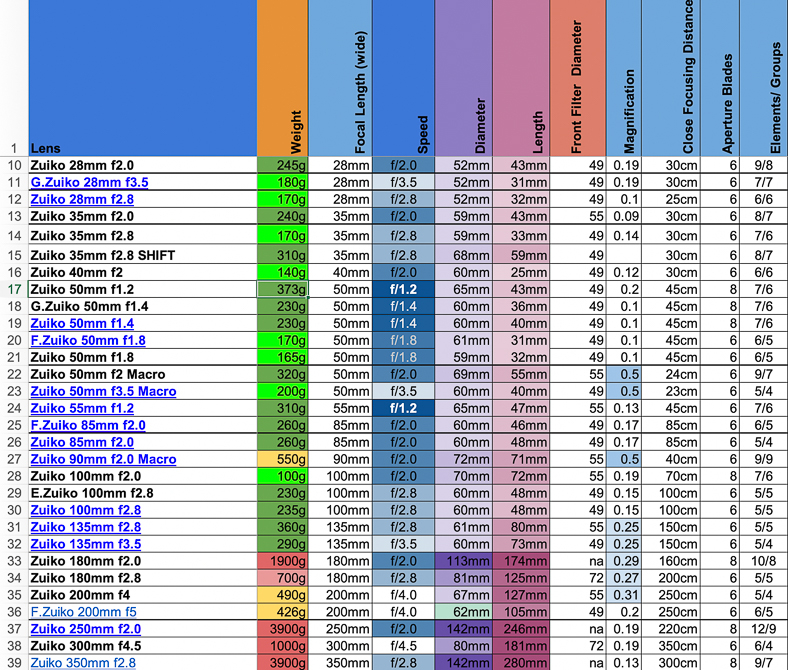
Lenses in the guide
The lenses we discuss now are mostly ones we have used fairly extensively and have samples. Ones none of us have ever used we are usually leave out or discuss briefly with no sample. When we have used two versions of a lens, and have samples, we list both versions. The samples and opinions are by David, unless it says otherwise.
The indicative prices are for lenses in good condition if you are are patient and wait around or try auctions. If you want perfect collectible condition, or want one really quickly, you may have to pay more.
Olympus Zuiko Fisheyes and 18mm.
None of us has used either of these extensively enough to have an first hand opinion about their quality. The 18mm has quite a good reputation, but is quite expensive. We would be surprised if it was as optically good as even a modern zoom covering the range, but it is compact, and unlike many legacy 18mm lenses probably gives good enough quality to not distract from the images if you are shooting film.
2.8/8 fisheye | 640 | $800 | Ebay.com (affiliate link)
2.8/16 fisheye | 180g | $550 | Ebay.com (affiliate link)
3.5/18 | 250g | $700 | Ebay.com (affiliate link)
Olympus Zuiko 21mm f3.5
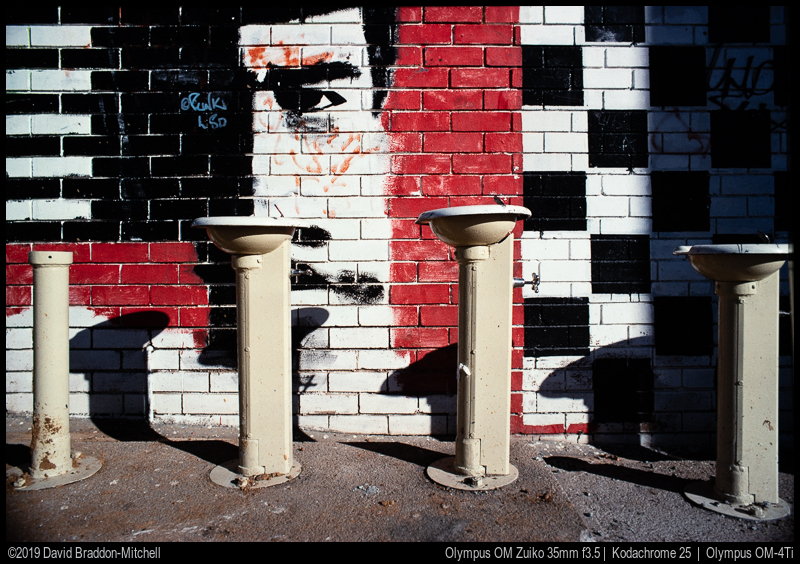
Status: Owned and used extensively by David in the film era. Not part of current kit.
- Usable resolution and contrast
- High vignetting, especially wide open
- moderately high distortion
- Small and lightweight
A small and lightweight prime lens which for a while was a favourite for people adapting lenses for mirrorless because there were no issues with the sensor stack. It’s a good little performer and fun to use, but it’s not enough cheaper than the CV 21/35 to be a first recommendation for a compact 21mm. As far as we know the different versions of this lens are differences in coatings only.
185g | $250 | Ebay.com (affiliate link)
Olympus OM Zuiko MC 24mm f2.8 (Phillip)

Status: Used on Sony a7II for about a year by Phillip. Sold since.
- A tiny lens
- Sharp across the frame by f/8
- Weaker flare resistance
- Very high vignetting, even stopped down
- Relatively affordable
The Olympus 24mm f2.8 has some shortcomings like weaker flare resistance and stronger vignetting which limit the applications you can use it for but it shares those with most other wideangles of its era. Since it is rather cheap and very small it can still make good sense in your kit because it performs very well if you aren’t too crazy about taking backlit images.
180g | $100 | Review | Ebay.com (affiliate link)
Olympus OM Zuiko 24mm f2.8
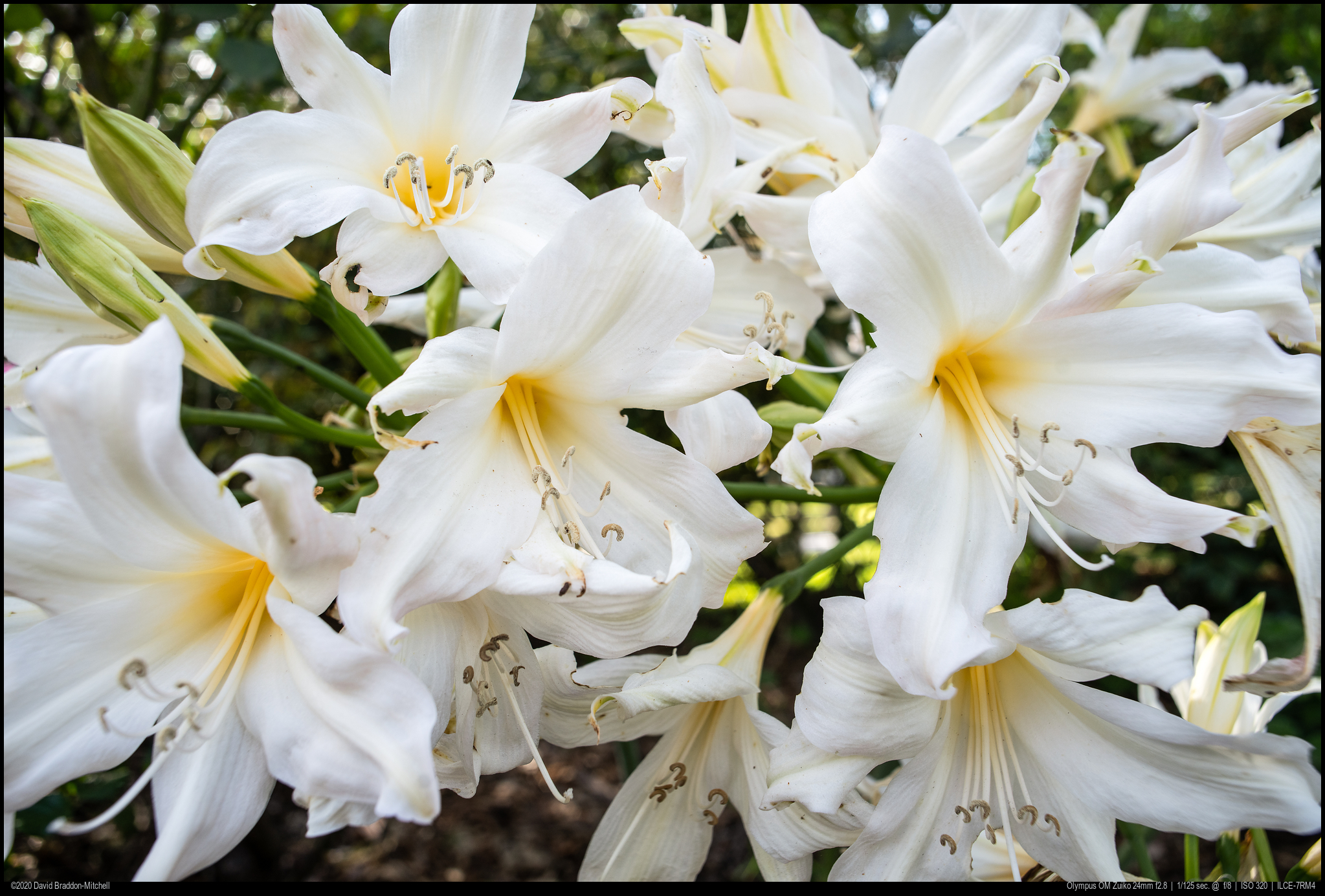
Status: Currently owned by David mainly for use with infrared film on an OM body.
- Optically and mechanically the same as the Zuiko MC version
- Maybe slightly better against the light
This is the final version of the 24mm f2.8; it is also multicoated but it seems may have a new style of coating – the so-called New Multicoating NMC. It certainly seems quite good against the light, but unfortunately we don’t have access to both this and the earlier one to compare them against each other. None of us has tried the earlier H.Zuiko single coated version, but we suspect that in a lens of this width and complexity it would be very poor against the light. Both versions, by the way, are very good performers in the infra red, with no hotspotting.
180g | $150 | Ebay.com (affiliate link)
The Fast Super Wides: 2/21 and 2/24
I have used these briefly in the past. They are very expensive now, and in fact optically neither are as good as the slower lenses, while still fine optics. Since their wide open performance is a bit iffy, I don’t think they make sense for digital. For film, the extra speed makes them easier to focus accurately, which might for some make it worth the extra cost, size and slightly lower stopped down quality.
250g | $600 | Ebay.com (affiliate link)
275g | $370 | Ebay.com (affiliate link)
Olympus Zuiko MC 28mm f2
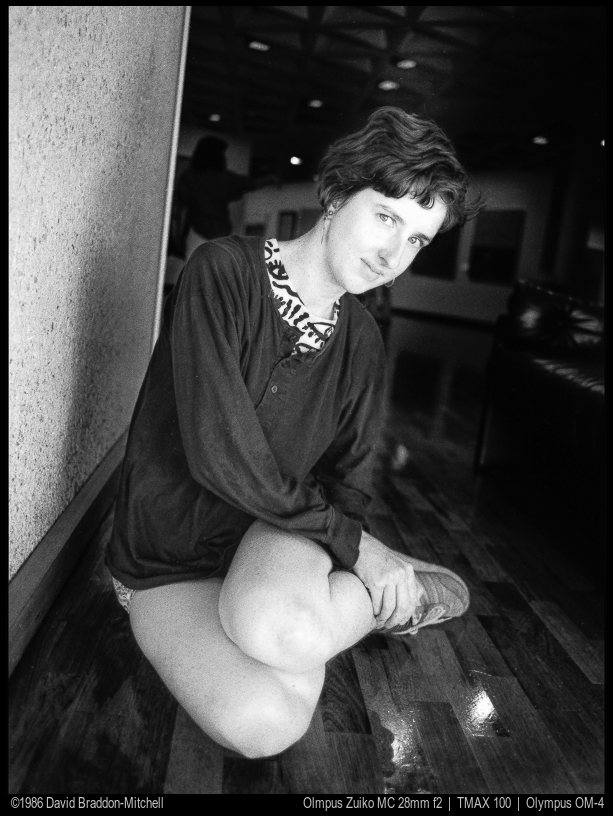
Status: Bought by David and used in the days of Film. Bought by Phillip for review. David has a later version now for retro fun with film, but hasn’t used it much yet.
- Decently sharp centrally at wide apertures, quite sharp across the field stopped down. Some sample variation.
- Soap bubble bokeh in high contrast back-lit situations with specular highlights.
- Later versions appear to do better in backlight, all versions are better than you would expect for a fast wide of the era.
An interesting lens that someone who likes the look of vintage fast wides might well invest in, as it handles flare better and is sharper than most fast wides of its era, whilst retaining that look to the bokeh. Not that cheap, and so if you are just looking for a lens with no particular interest in classic lenses, the Sony 2/28 is a better bet. Although I have a later NMC version, I’ve not yet tested it.
240g | $200 | Ebay.com (affiliate link)
Olympus G.Zuiko 28mm f3.5
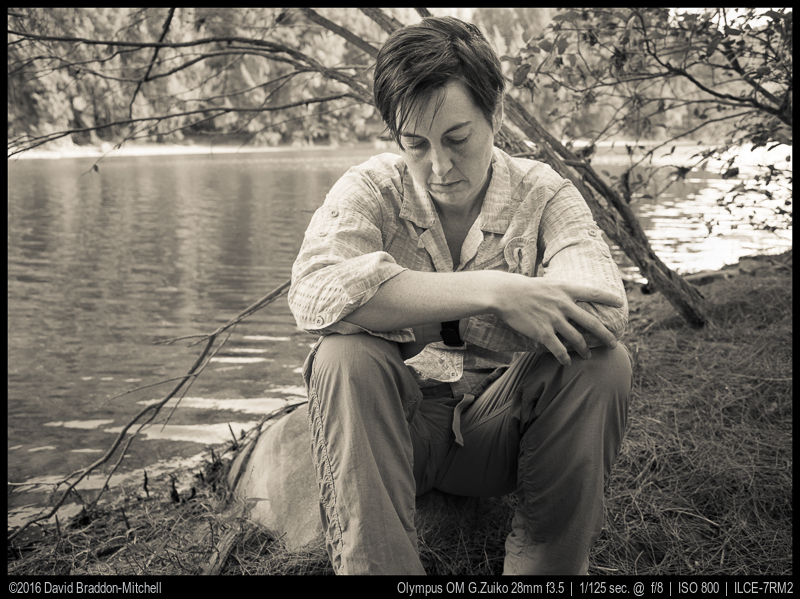
Status: Bought by David in digital era and still in use.
- Very sharp across the field from one full stop down.
- Small and compact.
- Average for the era control of flare and backlight.
- Quit good contrast when lighting conditions favourable.
This lens is reputed to be sharper than its replacement, the 28mm f2.8. Although I have used both, we haven’t had them together to test so we can’t confirm that. I can confirm though that the later lens handles flare a bit better, though this one is not too bad considering it is probably not fully multicoated. This lens is however very sharp indeed, and well priced, and a good choice for someone looking for an inexpensive but sharp 28 for their kit.
180g | $60 | Ebay.com (affiliate link)
Olympus OM Zuiko 28mm f2.8
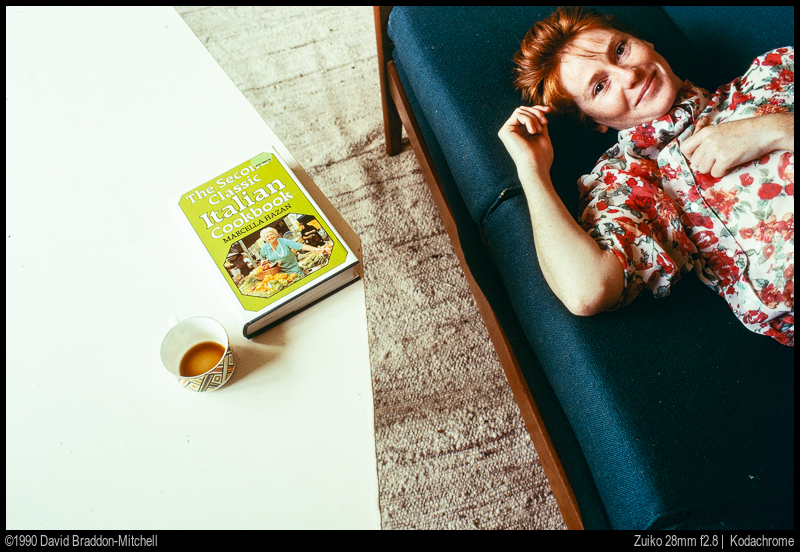
Status: Bought and used by David in the days of film. Not part of current kit.
- Very sharp across most of the frame. Possibly a tiny bit worse in the corners than the earlier f3.5 version, but we can’t compare them side by side any more.
- Very high contrast and food flare control
- Very small
A nice lens which con be got cheaply and makes sense as a “student” purchase. Better contrast than the f3.5, but as we say above, the rumour that it’s worse in the corners is something we can’t verify. I always found it remarkably sharp across the field
170g | $50 | Ebay.com (affiliate link)
Olympus OM Zuiko MC 35mm f2
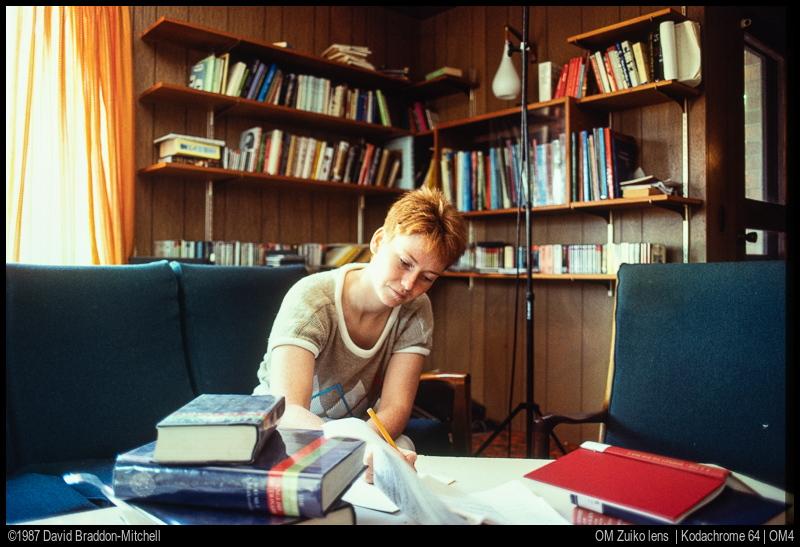
Status: Bought and used by David in the film era.
- Quite nice rendering in some situations
- Compact for an f2 35 of the era
- Useful sharpness but not amazing
- Bokeh wide open tends to outlining with backlighting and specular highlights
I always found this lens sharp enough and decent corner to corner stopped down. But it has a poor reputation in some circles. If there is demand from readers and enthusiasm from us one of us may find a good copy to review fully. It’s possible that the design was modified for the last production runs: it’s just a little longer — not enough longer to guarantee that it’s a recalculation with the same rough structure as with some lenses, but the difference is greater than with some of the lenses nonetheless. This might explain the disagreement.
240g | $160 | Ebay.com (affiliate link)
Olympus OM Zuiko 35mm f2
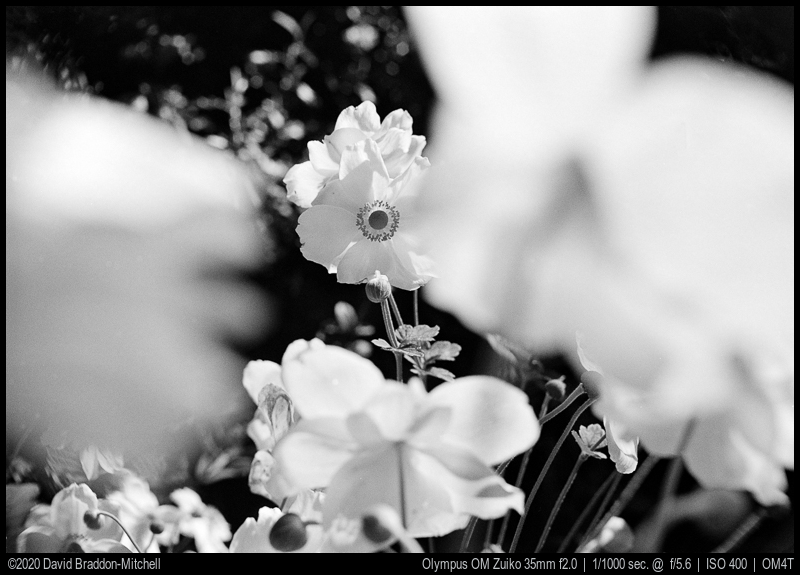
Status: Bought and used by David as vintage lens on digital, and occasionally for retro fun on an OM film body.
- Mostly the same as the Zuiko MC version
- Slightly better contrast than the non multicoated version, but not a big difference.
This is the final version of this lens. We don’t know it it was optically changed, but we doubt it. So probably the only difference is coatings. The oldest version, the H.Zuiko, was single coated, and given the design probably had contrast issues as a result. It’s also very rare, because Olympus introduced multicoating to this lens very early – a “silver nose” version can be found marked Zuiko MC.
It’s unclear when the redesign happened (and whether the redesign was only mechanical). Certainly the silver nosed versions, even marked MC, are the older body. I don’t know if the new design starts with the black body MC, sometime during the black body MC era, or with the new multicoating marked by MC being removed from the front ring.
240g | $250 | Ebay.com (affiliate link)
Olympus OM Zuiko 35mm f2.8
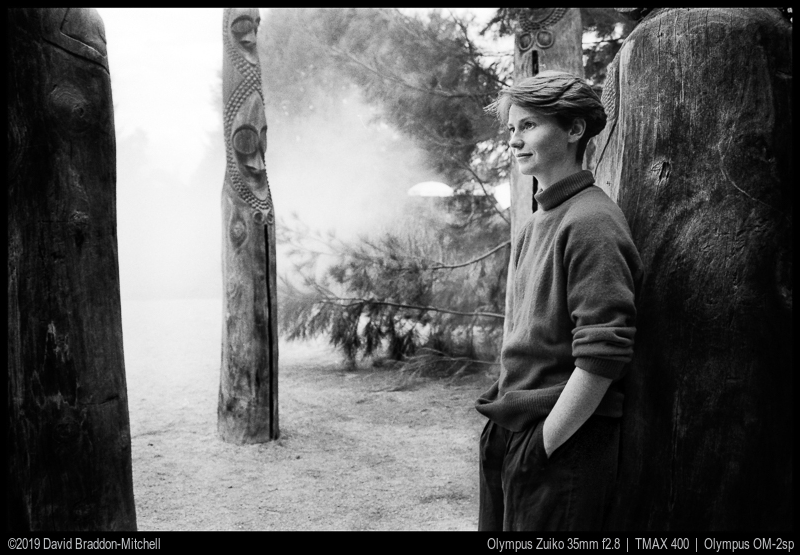
Status: Bought and used by David in the film era.
- Low cost
- Compact
- Later models sharp over most of the field by f5.6
- Later models somewhat sharper than the f2 version.
This lens is pretty inexpensive. We think that the later version must be redesigned as it is considerably larger and heavier than the original version. If you are not looking for a heavily vintage look it might pay to look for that version – with the plain “zuiko” label. On the other hand if you are looking for something far from the modern look (and if you were being tough you might say that the later version looks like an average modern lens, rather than a vintage one) you might prefer the old one.
170g | $80 | Ebay.com (affiliate link)
Olympus OM Zuiko SHIFT 35mm f2.8
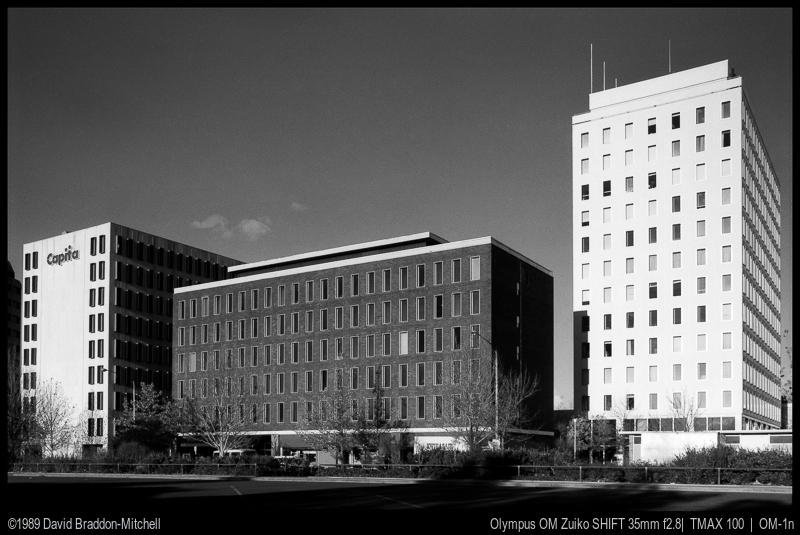
Status: Bought and used by David in the film era.
- Relatively inexpensive way to get into shift lenses
- Decent central resolution
- Edge resolution poor when anywhere near maximum shift
The only reason to get one of these is to experiment with shift lenses (or if you think old Zuikos are cool). Back in the day, when digital perspective control was impossible, it was a godsend. I loved this lens. But the IQ is not good enough to compete with using a slightly wider lens and correcting perspective in your software of choice, much less a contemporary shift lens. On the other hand if you are using film it still makes good sense.
310g | $300 | Ebay.com (affiliate link)
Olympus Zuiko 50mm f1.2
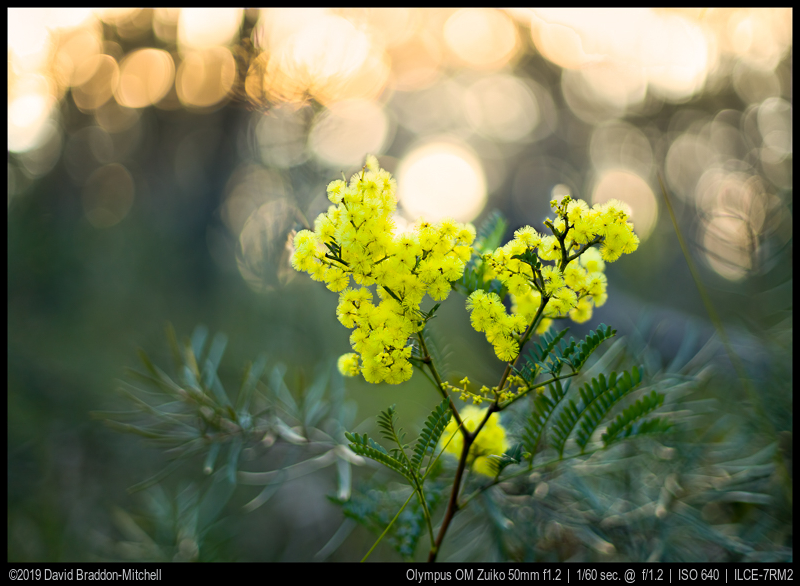
Status: owned and used by David in the digital era.
- Interesting “classic” fast fifty bokeh at wide apertures
- Usable wide open
- Quite sharp stopped down
- Nice size and weight compared to other f1.2 fifties
- Can be expensive, look for a good deal
This lens gives you f1.2 fun at wide apertures, and stops down to be an excellent all round fifty with not too much weight penalty. There are only two reasons to consider it. One is that you want the classic f1.2 fifty look. In which case it’s one of the best options. The other is that you are looking to save money and still get f1.2. In that case you will need to find a bargain. The CV 1.2/50 is a much better and smoother lens, and if smoothness, resolution and contrast are what you would prefer, that would be a better bet unless you can get this lens at a bargain price. I have a lot of fun with this, though! There is an older version I haven’t used: the 55mm f1.2. It is reputed to be less sharp and contrasty, and also to have been crazier bokeh. But these might all be features you want for some use cases!
373g | $450 | Ebay.com (affiliate link)
Olympus G.Zuiko 50mm f1.4
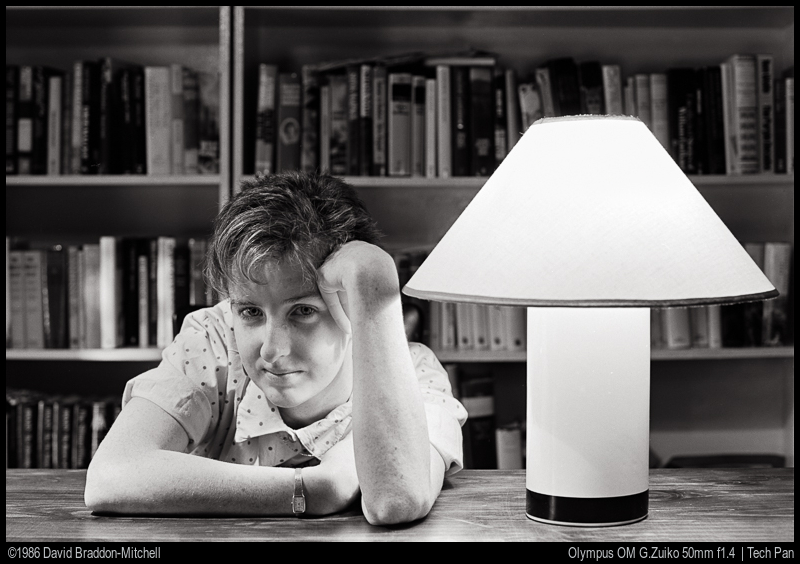
Status: Owned and used extensively by David in the film era. Sold in the film era to upgrade to never version.
- Good bokeh for a classic double gauss 1.4/50
- Very good sharpness stopped down a stop or two
- A little hazier wide open than later version but still comparable to most classic 1.4/50 lenses
- Inexpensive and a very good choice for film or if on a budget
This earlier version of the classic 50mm lens is a good all round fifty, if not quite as good as the more expensive serial no >1.1m version. The black nose and silver nose version of the G.Zuiko are merely cosmetically different as far as we can tell.
230g | $60 | Ebay.com (affiliate link)
Olympus Zuiko 50mm f1.4
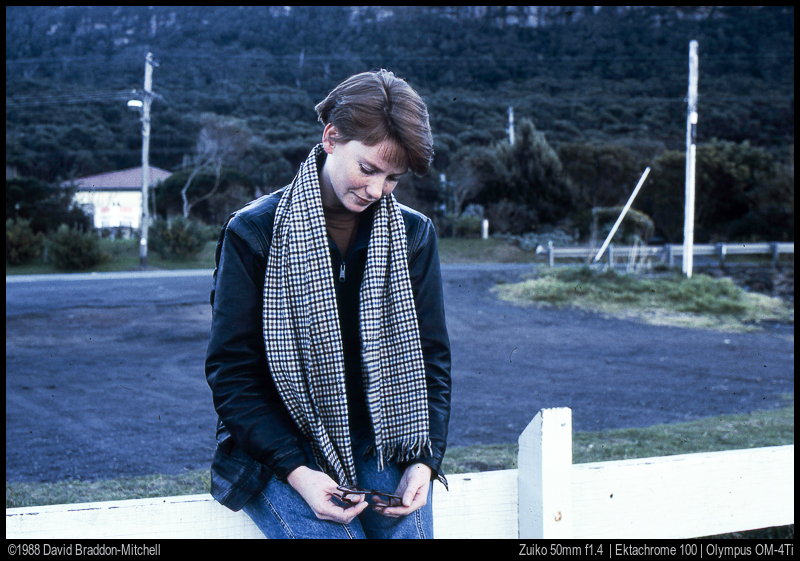
Status: owned and used by David in the film era. New copy in occasional use on digital and film.
- Good bokeh for a classic double gauss 1.4/50
- Late version has very good central and midfield sharpness wide open for a classic 1.4/50
- Better LoCA correction than even some modern lenses
- Sharp across field stopped down, but not modern sharp
- Nice size and weight
- Good choice if you are looking for a classic 1.4/50, as it’s one of the better ones and smaller than most
This is a lovely classic standard lens, but it comes in many versions. This last version has both the latest coatings and a different optical design (from serial number 1.1 million on say many). The middle version none of us has used marked “Zuiko MC” is fully multicoated, but may or may not have the last optical design. This version is a little better at wide apertures than the early ones.
240g | $180 | Ebay.com (affiliate link)
Olympus F.Zuiko 50mm f/1.8
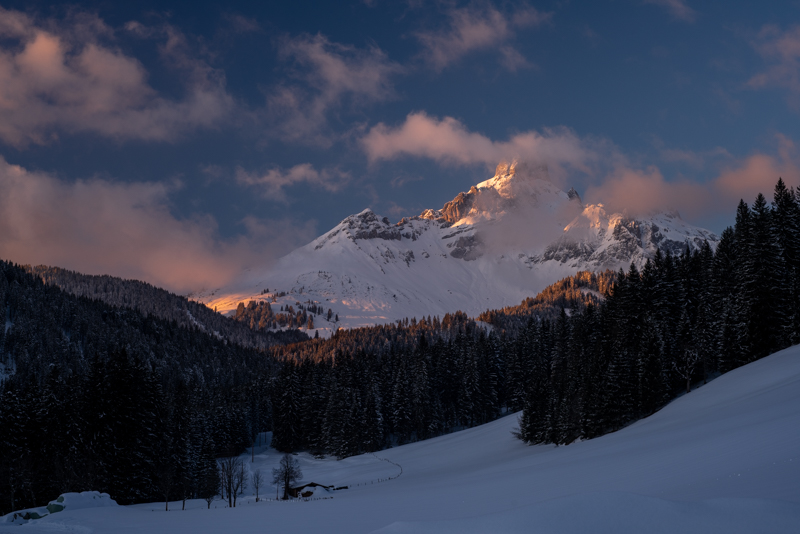
Status: Currently owned by Juriaan and used from time to time.
- Very small and light
- Very sharp from edge to edge stopped down with barely any LaCA
- Good bokeh near minimum focus distance
- Not sharp wide open, especially away from the center
- Corners never get really good
- very bad flare resistance
The first design of the Olympus 1.8/50 series. Sharpness is not great and due to primitive coatings flare resistance is horrible.
At longer distances bokeh is nervous with loads of outlining, however near MFD bokeh is very smooth. The F.Zuiko 1.8/50 can be found cheap and is a nice lens to walk around with due to its limited weight. If you like the bokeh rendering a lot but you are looking for a sharper lens and better coatings, check out the latest version.
170g | $50 |Ebay.com (affiliate link) | review
Olympus Zuiko 50mm f1.8
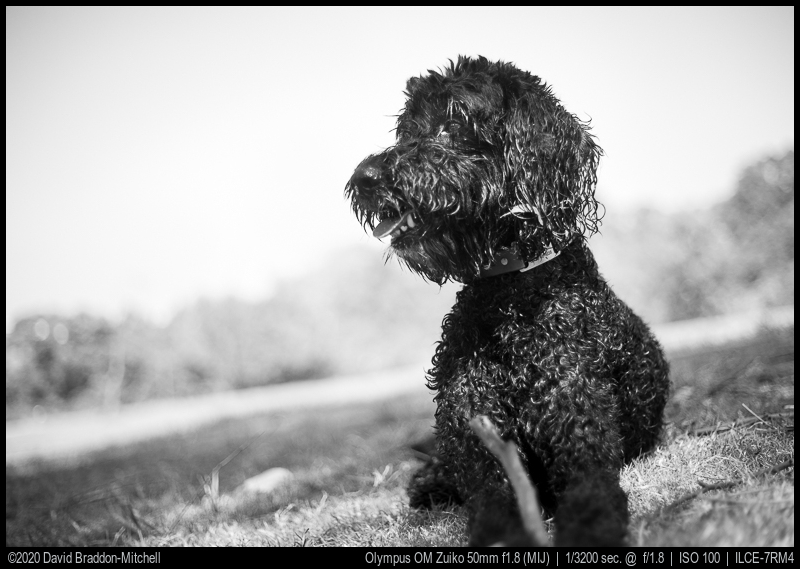
Status: owned and used by David in the film era, another copy currently owned by David for film and digital use.
- Very small and light
- Very sharp from corner to corner stopped down.
- Low LaCA
- Good bokeh at close distance
- Decently sharp in a large central region wide open
- Good corners
- Decent performance against the light
The optical design as well as the coatings were changed on the basic 50mm lens at some point. Exactly when is unclear, but the scuttlebutt is that the lenses that say just “Zuiko” with no “MC”, and which say “Made in Japan” are of the last design. I think it’s safe to say that all such lenses are the later one, possibly some earlier ones are too, but possibly not. You will have to look through eBay carefully to find one. Our affiliate link will eliminate the F.Zuiko versions, and most Zuiko MC but look at the front ring in the picture before ordering/
It’s a great little standard lens. Has slightly distracting bokeh by some lights, but it’s sharp in a decently large central area even wide open, and gets very sharp stopped down. A very sensible lens if you are playing with film on an OM, and an inexpensive fast manual fifty for digital, that is probably plays in a similar league optically than the cheaper modern ones.
170g | $50 | Ebay.com (affiliate link)
Olympus Zuiko 50mm f2 Macro
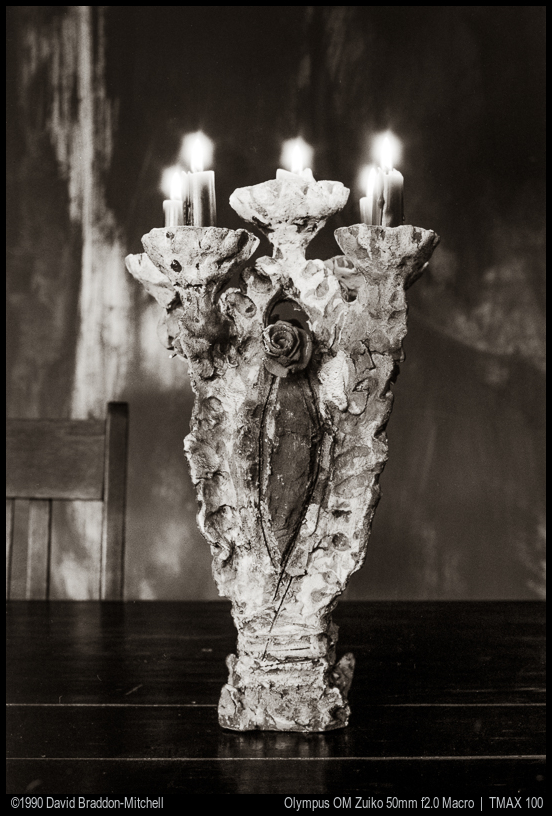
Status: owned and used by David in the film era.
- Outstanding contrast and colour at all apertures and distances
- Good macro performance at 1:2
- A little smaller than eg Zeiss Makro-Planar 2/50 while in the same class
- Suffers from collector premium
One of the last generation of very high performance Zuikos this lens had great performance, although it was not as compact as most zuiko lenses. It can sometimes be had at a price that makes it competitive with the very similar Zeiss Makro Planar Classic 2/50. Either is a very nice optic on Sony; get whichever is cheaper.
320g | $350 | Ebay.com (affiliate link)
Olympus Zuiko MC 50mm f3.5 Macro
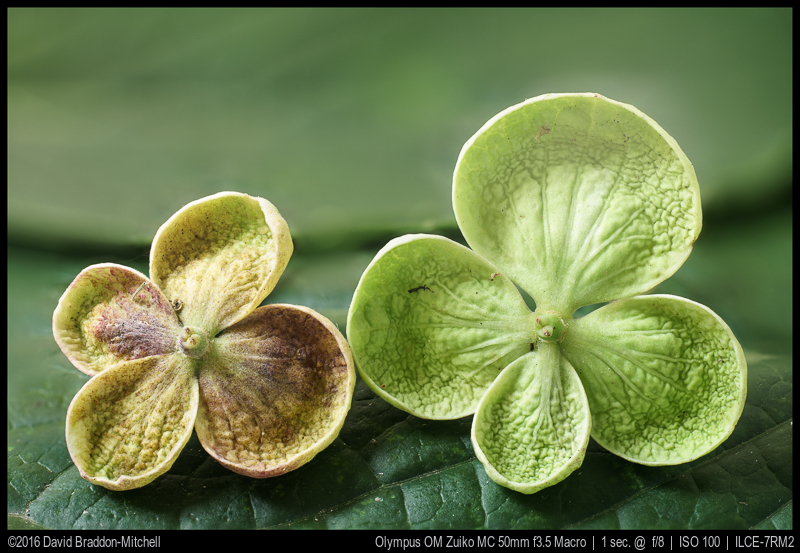
Status: owned and used by David in the digital era. Owned by Phillip and reviewed here.
- Outstanding lens at it’s optimum magnification at 1:1
- Decent at 1:2 and infinity
- Small and compact
- Not as cheap as it was, but still a nice affordable way to get a macro for Sony or for film.
The image is made with the MC version, but all versions are very similar. It’s a good sharp lens at normal distances, and ideal at 1:10. It may not have the sparkle of the much more expensive f2 version, but of all the macro lenses of its era it’s at least as good, and much more compact. A definite recommendation, and usually easy to find and not too exepensive
200g | $70 | Ebay.com (affiliate link)
Olympus G.Zuiko 55mm f1.2
This is a bigger lens, with 55mm filter threads, and not as sharp as the later 50mm f1.2, and has even funkier bokeh. None of us has used it extensively, but our sense from samples and other sources is that it’s only for people who want to experiment with crazy bokeh. As a user lens for most purposes the 50mm f1.2 is preferable.
310g | $300 | Ebay.com (affiliate link)
Olympus F.Zuiko 85mm f2.0
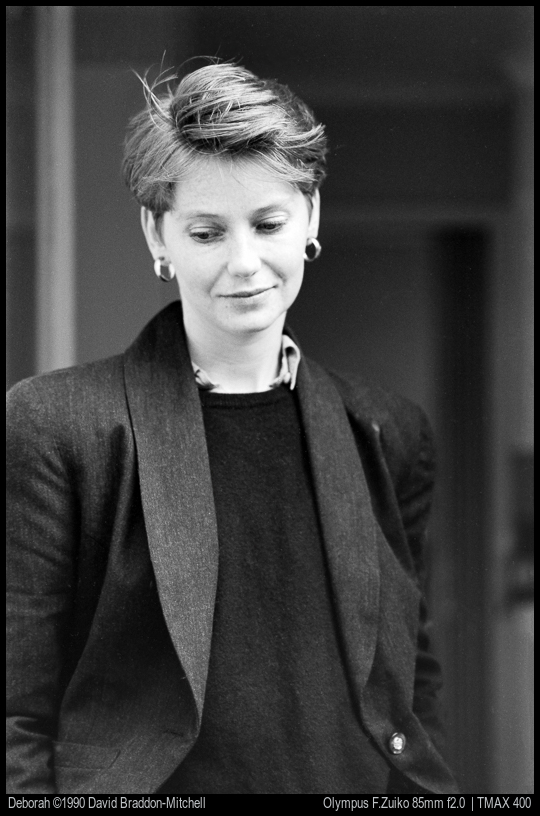
Status: Bought and used by David in the film era
- Very small
- Nice bokeh
- Not as sharp as later one, but some prefer it
This is the first version of the lens, a 6 element Sonnar design. It’s a little soft wide open compared the the later (Only 5 element, but sharper version). Some people prefer this for portraiture, and think it has a “true sonnar” look. I had the old version, and now the new, and I can’t tell anything about the look really except a little more resolution in the centre wide open in the new one (and the expected effects from more modern coatings.
260g | $220 | Ebay.com (affiliate link)
Olympus Zuiko 85mm f2.0
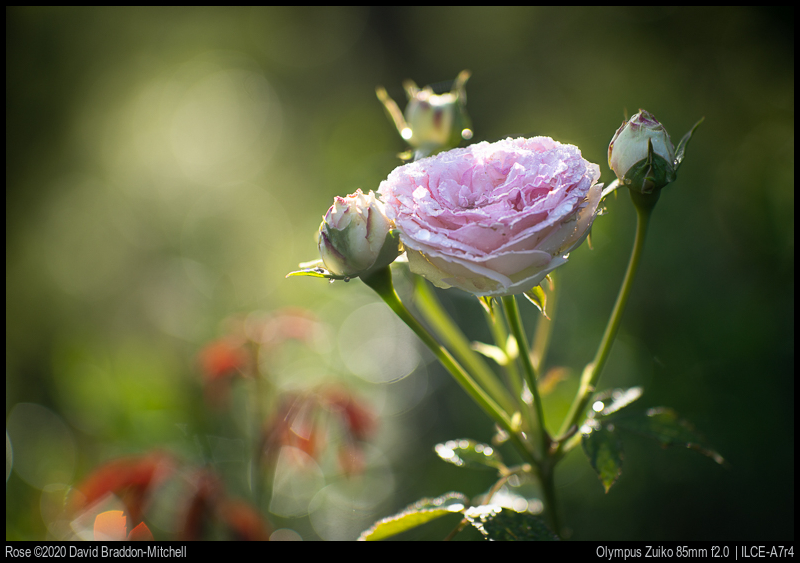
Status: Bought and used by David on digital and for retro fun on film
- Very small
- Nice bokeh
- A little sharper and better contrast than previous version
This is the later 5 element redesign. Don’t fall prey to the assumption that just because it has fewer elements it’s worse. As time goes on designs improve so you can get better or the same performance with fewer elements. There is no evidence that later redesigns were the result of cost cutting. It seems to me to have the same bokeh as the previous version, and a bit better resolution and contrast, though some disagree. The “Zuiko MC” version has the later design as well as this last version, just perhaps different coatings from the final version.
Any version makes a delightfully compact little fast tele on digital or film.
260g | $260 | Ebay.com (affiliate link)
Olympus OM Zuiko 90mm f2
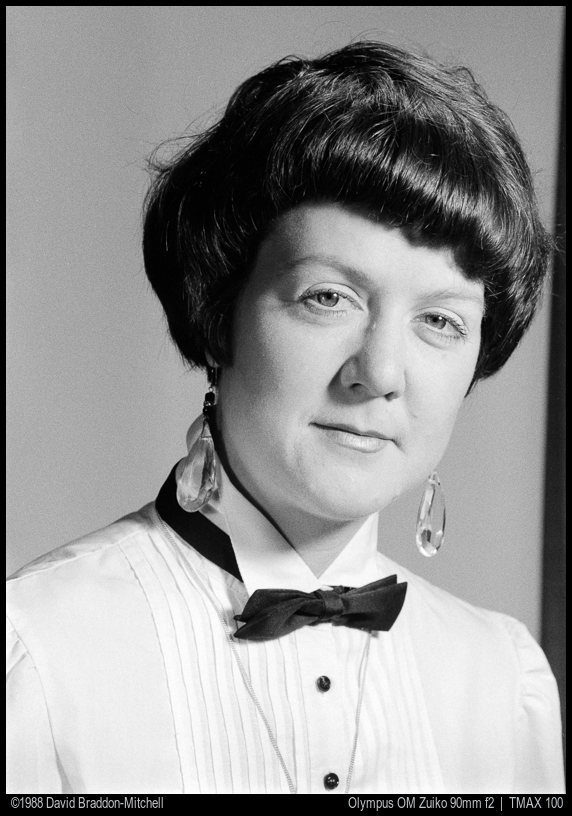
Status: Bought and used by David in the film era
- Extremely sharp and contrasty
- Excellent at all distances
- Has 1:2 macro of high quality
- Bokeh slightly more distracting than 2/100 at longer distances
This lens is legendary; it was produced towards the end of the OM era and was part of a series designed to showcase their optical prowess. It’s probably a better lens than the Zeiss Makro-Planar 2/100 – it certainly has less purple fringing, and it’s more compact.
But as with a lot of these lenses, collectors have spoiled the party. Unless you find one cheap, you are probably better off with the CV Apo-Lanthar 2.5/110 which is better still, and goes to 1:1, and has contacts.
550g | $450 | Ebay.com (affiliate link)
Olympus OM E.Zuiko 100mm f2.8
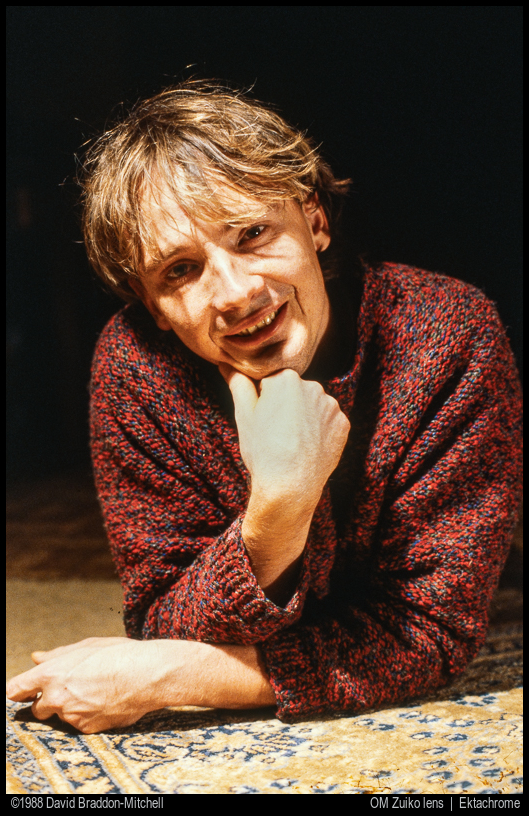
Status: Owned and used back in the days of film by David
- Very similar to later multicoated version (see next section)
This is a lovely little lens; see the next section for discussion of the multicoated version. This earlier version is basically the same: the lens is simple enough that multicoating makes very little difference, and the earlier F.Zuiko version can be had very cheaply. Highly recommended for film users, or anyone looking for a small and inexpensive short tele for digital.
230g | $120 | Ebay.com (affiliate link)
Olympus OM Zuiko 100mm f2.8 (Phillip)
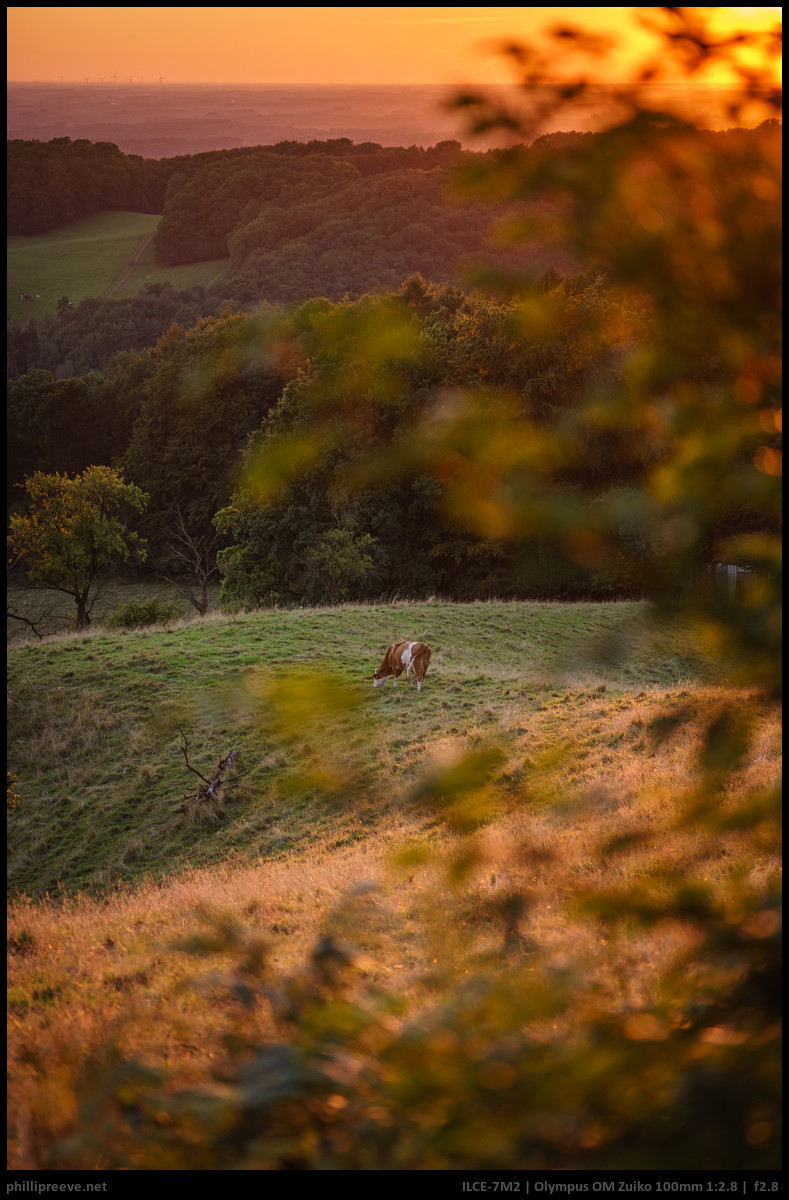
Status: Used on Sony a7 for two years by Phillip. Sold since.
- A tiny lens, no bigger than your typical 1.8/50
- Sharp across the frame from wide open with decent contrast
- Good bokeh most of the time
- Stronger CA
- Very affordable
The Olympus OM 2.8/100 is a tiny lens with a generally good performance and few limitations. I think it is a great choice for those occasions when you don’t want to carry a heavy bag. Despite these positive characteristics, the lens is quite affordable and I think it offers great value.
230g | $90 | Review | Ebay.com (affiliate link)
Olympus OM 100mm f2 (Phillip)
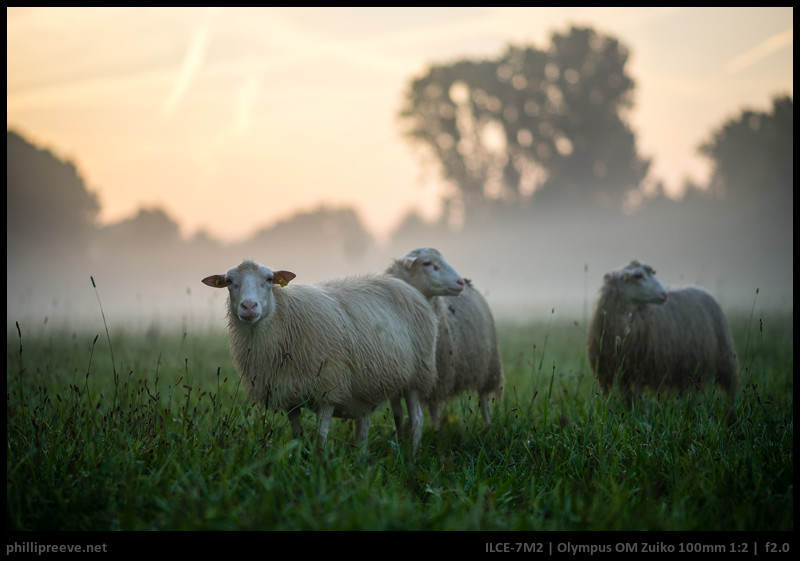
Status: Used on Sony a7II for two years by Phillip. After the 2.5/110 APO arrived it saw too little use and was sold.
- Very sharp across the frame from wide open with high contrast
- Outstanding bokeh
- Above average but far from perfect CA correction
- Focuses to 70 cm with good sharpness thanks to floating elements
An excellent lens which balances performance and handling really well. Its biggest competitor is the 2/90 Macro which is a little sharper and focuses even closer but the 2/100 has a little nicer bokeh and less steep focus throw.
Since it is a rare lens, prices are usually unreasonably high which makes it hard to recommend for actual usage to any but die hard Olympus fans.
520g | $6-800 | Review | Ebay.com (affiliate link)
Olympus OM Zuiko 135mm f3.5
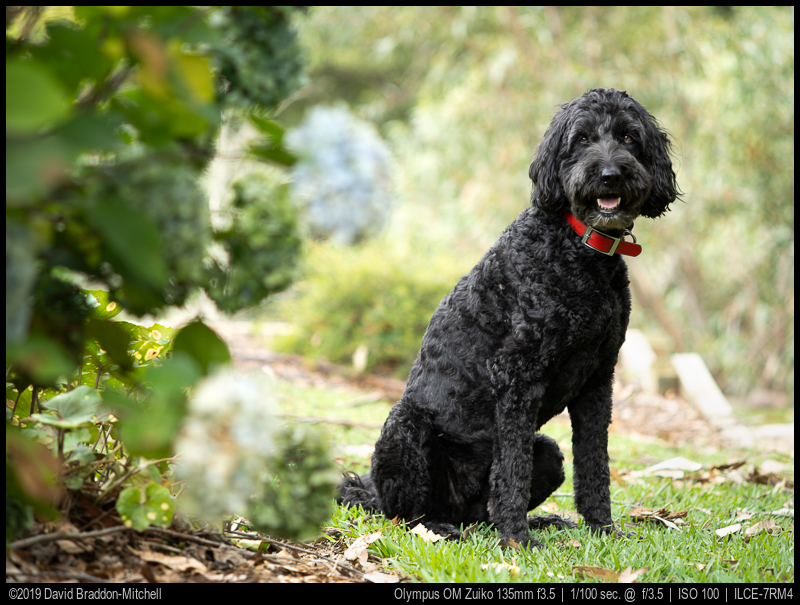
Status: Bought and used by David in the digital era
- Reasonably sharp across the frame
- Very sharp at close to medium distances, less good at infinity
- This version has high contrast
- Noticeable LoCA
- Cheap if you can find one, and one of the smallest 135mm lenses
Quite a fun lens to use because decently sharp and very small. This version is very hard to find, however. The E.Zuiko version which is widely and cheaply available is optically the same, we think, and different mainly, or only, in coatings.
290g | $30 | Ebay.com (affiliate link)
Olympus Zuiko MC 135mm f2.8
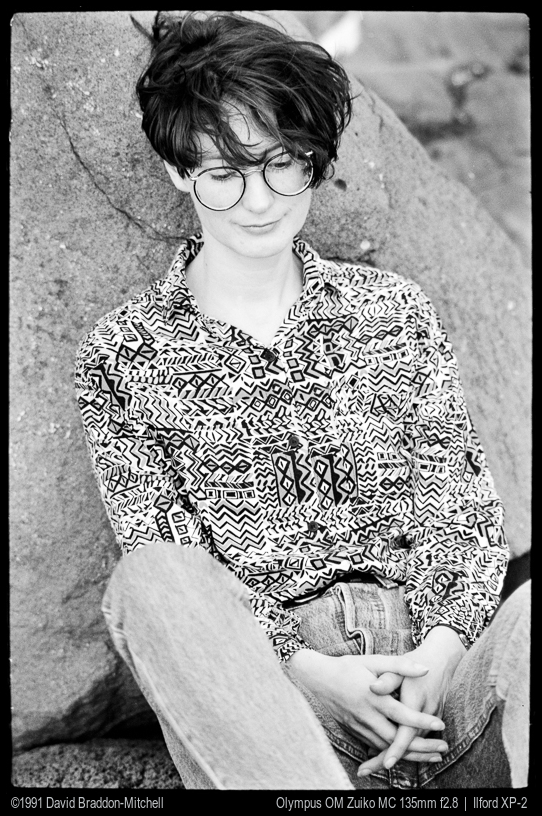
Status: Bought and used by David in the film era.
- Sharp and decent classic fast 135
- As with most classic non-Apo teles displays some LoCA but less than most.
- Nice Bokeh
This lens is not expensive, and while not as good as say the Batis 2.8/135 its a tenth of the price. If you want a manual f2.8 for occasional use, and don’t want to pay a lot of money this lens makes good sense. As far as we can tell there are no optical differences between versions, only coatings.
360g | $100 | Ebay.com (affiliate link)
Olympus Zuiko MC 200mm f4
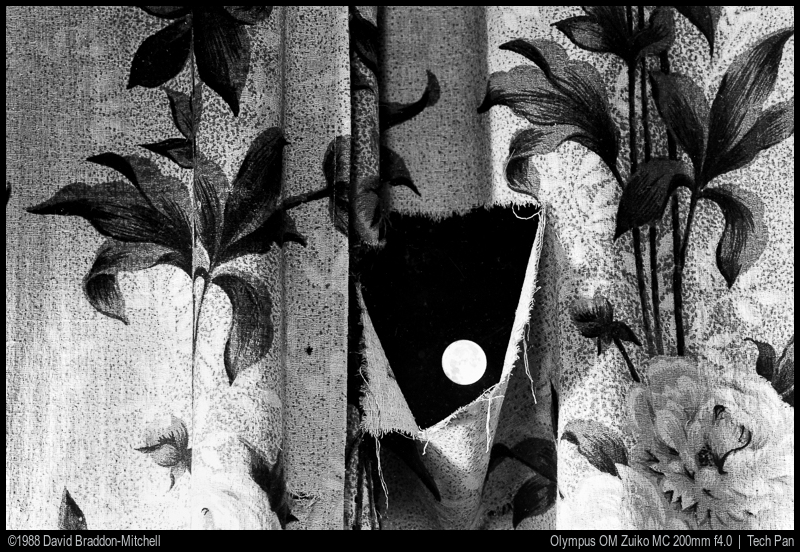
Status: Bought and used by David in the analog era. A later copy now in use for digital.
- Decently sharp wide open and stopped down
- Not too big or heavy
- As with most classic non-Apo teles displays some LoCA but less than most.
- Bokeh quality quite good (but limited in speed)
No-one makes a portable and small tele lens any more, as zooms rule the roost for this focal length. So if you want such a lens you have to adapt. Probably the Apo-Lanthar 180mm f4 from CV is the best of the compact options, but it is priced absurdly. This lens is very affordable, and might make a good stopgap for your kit. Of course you might prefer the even more compact f5 version, though finding a multicoated copy of that is very difficult indeed.
490g | $60 | Ebay.com (affiliate link)
Olympus Zuiko 200mm f5
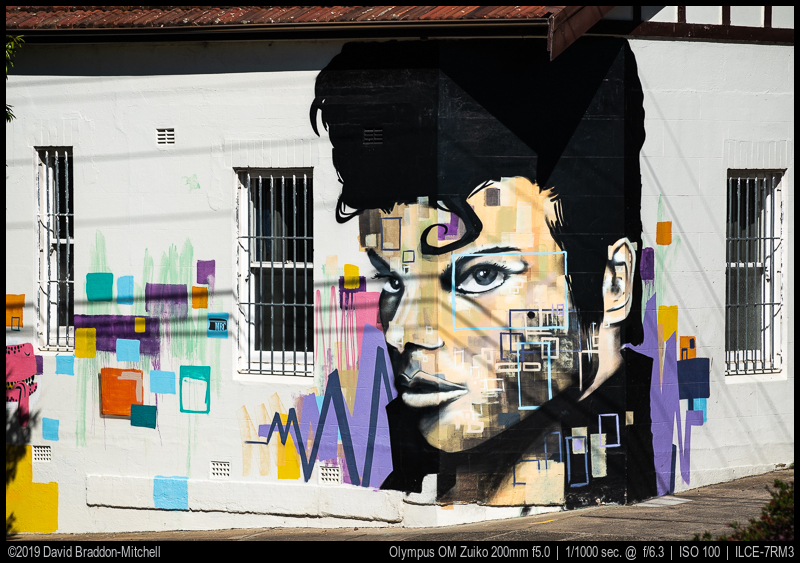
Status: Bought and in use on digital by David
- Decently sharp at all apertures
- Very compact
- Late version fairly flare resistant
- Good at infinity as well as closer distances
This lens was designed for compactness, and it certainly succeeds. The optical design, it seems, was slightly altered for the last run (the “plain Zuiko” run) and is slightly better at some distances, and has better coatings than the early ones. However the last version is very hard to find. Ones for sale are almost always the G.Zuiko version. They are pretty cheap, so it might be worth trying for your compact tele needs, or you may prefer to get the slightly faster (though larger) f4 versions, which is more easily found in a “Zuiko MC” or later version. It is a very small lens, so until someone makes a compact manual modern medium tele lens, this might make sense stashed in a corner of your bag if you aren’t a big tele user.
426g | $90 | Ebay.com (affiliate link)
Olympus Zuiko 180mm f2 (Bastian)
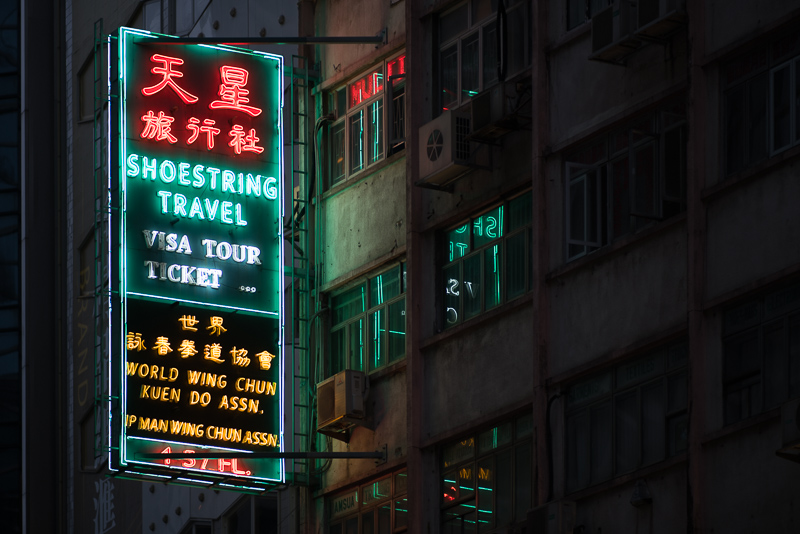
Status: Bought and sold by Bastian.
- Great build quality
- Really good minimum focus distance
- Nice bokeh
- Very good sharpness at all distances (floating elements design)
- Average amount of vignetting, flare resistance and correction of longitudinal CA
- Very rare and expensive
Amazing design considering its age: ED element, great minimum focus distance, surprisingly compact and lightweight.
Unfortunately this is a really rare lens which has only been produced in very small quantities. Therefore it is mostly a collector’s item and only sells for collector’s prices.
For the price of a really good used one it is probably smarter to get a modern lens like the Canon EF 200mm 2.0 L IS, but this doesn’t take away from the fact that the Olympus 2/180 is an amazing lens.
Weight: 1900g | Filter Thread: 100mm (rare!) | Price: $2500+
Review | ebay.com (affiliate link)
Olympus Zuiko 250mm f2 (Bastian)
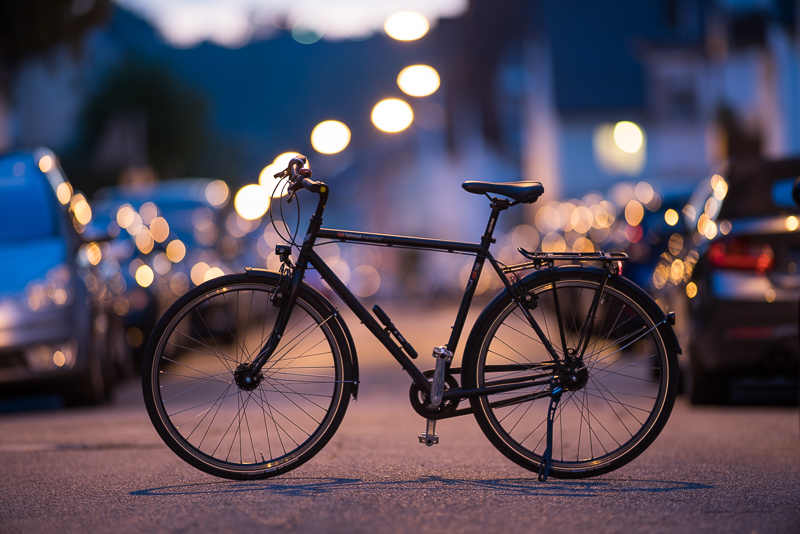
Status: Bastian could have a look at a faulty loaner.
- Great build quality
- comparably good minimum focus distance
- Amazing bokeh (especially amount)
- Very very rare and expensive
In many ways similar to the aforementioned 2/180, but an even bolder design and truly one of its kind. It is similarly hard to find as the 2/180, but even more expensive.
If you are into Brenizer this may be your holy grail lens, but these days most that are still in good condition are certainly to be found in some collector’s dry cabinet.
Weight: 3900g | Filter Thread: 46mm (slot in) | Price: $5000+
Hands on | ebay.com (affiliate link)
Olympus Zuiko 350mm f2.8 (Bastian)
The design is very similar to the two aforementioned lenses, but none of us has used it personally yet.
It is the cheapest and easiest to get of these three Olympus Super-Tele lenses, but it competes with some of the older Canon 2.8/400 lenses which can often be found cheaper and therefore might be a more sensible choice.
Weight: 3900g | Filter Thread: 46mm (slot in) | Price: $2500+
ebay.com (affiliate link)
Olympus Zuiko Old-Style Telephoto lenses
Olympus made a range of big black older long focus style telephoto lenses. David has used the 300mm f4.5; it’s fairly heavy at a kilo, and of good quality for its era but doesn’t really make sense as a user lens unless you find it very cheap. The longer lenses – 6.3/400, 6.5/600 and 11/1000 (!) are huge and heavy and slow – its hard to see a purpose for them in todays world. They were near impossible to focus on film, but a bit easier on mirrorless. I could almost see someone using the 600 for wildlife if they could find it cheap enough and were comfortable with manual focus.
Closing Remarks
Good luck in your search for Zuiko OM lenses! Whether you are looking for a high quality and compact film system, cheap compact neutral lenses for digital, or funky older fast lenses for the vintage look, there are OMs for you all!
Articles like this require many hours of work. If you found it helpful, you can support us by:
- Using one of our affiliate links if you buy a lens (or anything else, nappies for hand sanitiser perhaps), it won’t cost you anything extra but helps us a lot.
- Sharing this article in social media
Other Articles
- All our other Guides
- Sony FE lens list with all current E-mount lenses
- User-Guide to wide-angle lenses for Sony a7 series
- All our lens reviews
- Tripods for Mirrorless Cameras
- Backpack Review: Mindshift Gear Rotation 180° Horizon
- Affordable manual lenses for the Sony a7 series
Support Us
Did you find this article useful or just liked reading it? Treat us to a coffee!
![]()
![]()
![]() via Paypal
via Paypal
This site contains affiliate links. If you make a purchase using any of the links marked as affiliate links, I may receive a small commission at no additional cost to you. This helps support the creation of future content.
David Braddon-Mitchell
Latest posts by David Braddon-Mitchell (see all)
- Laowa FFii 90mm F2.8 CA-Dreamer Macro 2x: getting close! - August 21, 2022
- FLM Ballheads: a rediscovery - February 4, 2021
- Laowa 14mm f4 Detailed Review - December 31, 2020
I’ve heard Zuiko F2 primes are legendary, but for users, I think they are too pricey for what they are. But other slower, common lenses would be a good choice for whom building cheap and mobile lens kit.
TMI: The name Zuiko comes from a classic word ‘zuikou'(瑞光,ずいこう), means holy light or auspicious light. I think it is very suitable name for “Olympus”.
*FYI. English abbreviations are hard to learn XD
Yes, the name was the result of a company competition in pre WW2 days!
I think those ingenious classic wordplays like “Kwannon -> Canon”, “Nippon Kogaku+Ikon -> Nikon” are much appealing than modern “super performance”, “art” or other blunt, blend brand names.
Indeed.
Olympus itself is a bit like that; the original name was Takachiho Optical Co, Mt Takachiho being a mountain on which the Sun God is supposed to have ascended to heaven. Looking for a name with resonance in the West, they went with Olympus as being a mountain of the gods..
Wonderful to see such an in-depth passionately written article David! Sometimes I really wonder about the website’s future when I don’t see a new piece for a while, and then something like this pops up. Great work!
The old photos and experience you bring to the mix really makes for an interesting read.
Thanks Jim!
Yeah it was a labour of love.
We aren’t going anywhere, but Covid has slowed us down a lot – Phillip and I are teaching remotely, which is much harder work than lecturing or teaching in person, with much more preparation and after work. Jannik has a child with no open daycare or school, and Bastian and Juriaan are also busier than usual. So output may not be fast, but we aren’t going anywhere!!!
Thanks for this interesting comprehensive article. Do the Sony A7 cameras differ in suitability for the use of OM-lenses (e.g. due to sensor design, display resolution)?
The A7 cameras are pretty much ideal platforms for using OM lenses, unless you want to play with film
Obviously the sensor is the correct size, and the EVF allows much more accurate focus than was possible with an SLR, even one with a good focus screen and prism like the best OMs.
Because they are SLR lenses they tend to have ray angles that make them much less sensitive to sensor glass covers, unlike rangefinder lenses like Leica M lenses, so they don’t degrade in that respect much or at all on digital sensors.
There is a slight mistake in the lenses list table regarding Zuiko 250mm 2f lens the weight and focal length values seems to be missing one additional 0 🙂
in fact all that entry seems to be filled with false information.
Thanks. it was the “ghost” of a previous entry (you may have noticed that the 250 was there twice, once correctly, once as you described!)
I also notice the 35 SHIFT was missing, so I’ve added it.
You missed out my favourite OM lens; the 85 f2 ! It is a superb lens & I used it more than all my other OM lenses. I used it to photogragh my 2 daughters growng up; it was the perfect focal length for superstitious portraits. I’ve managed to find a used one, which I will never sell on. I have an OM1 body with a 50 f1.4 & a 28 f2.8 wide angle & I also use them on my Sony A7 mk2.
Good grief! I did too! It was only an oversight! I have samples and opinions. I’ll add it post haste. Thanks!!!
OK now I’ve added the 2/85 with a few words about the two versions…
Also 50 3.5 macro is missing 🙂
You are right! It was in the draft, somehow it got left out….I’l add it.
Fixed! Thanks for noticing that. A nice little lens.
unfortunately I can not confirm this, I had 3 samples 85mm f 2 all are mediocre.
This are the best OM Lenses in IQ (42 and 61 Mpix SONY):
24mm 2.8 use 5.6 or 8
28mm 2.8 use 5.6 or 8
50mm 1.4 (serial>1,15mill) use >4
50mm Macro 3.5 use 5.6 or 8
90mm Macro 2 use 2.8 or more
180mm f2 excellent lens, I still use for Wide field Astrophotography
For me the 100mm f2 ED was disappointing, needs f5.6 to get proper IQ.
Claus, sorry you seem to have a poor copy of the 100/2.
The one I have is one of the very best lenses I’ve ever used. It’s as good at ƒ/2 as it is anywhere slower!
A small correction on the 16mm fisheye. It’s f/3.5. The only OM lens I still have. Don’t use it much. It is really small. Gives a vintage look to photos. Lots of light falloff. Sharp in the center, but not so much towards the edges. Not much else currently available as far as rectilinear fisheyes, so I’m keep it for occasional use.
Thanks, another damn typo!
I have the Samyang 12mm full frame fisheye (which is what I assume you meant – a fisheye isn’t rectilinear by definition).
The Sammy is cheap and pretty good across the frame, bigger than the OM though.
Ron
What a good read! I have both 21mm f2 and f3.5. The Olympus 21mm f2 is actually sharper than the f3.5 version. It is sharp wide open, even at f/2.8 the sharpness is on par with its slower sibling at f/3.5 and surpassed the f/3.5 at the same aperture also with less vignetting.
Thanks Oscar.
I found the reverse with the two samples I had back then: yes the f2 was on a par wide open with the f3.5 wide open, and yes it was better at f3.5, but at f5.6 and f8 my f3.5 was noticeably better and more even.
But with these older lenses, there is a lot of sample variation, both original and through time, so it may depend on the particular pair one has!
I have 100f2 so I must be olympus die hard fan or just Zuikoholic 😂😂😂, good guide thanks for this, if there are any people that need help to cure the sickness please join Zuikoholics Anonymous and we can help
https://www.facebook.com/groups/493218291577146/?ref=share
If you have the 2/100 you are definitely a Zuikoholic! I have fought hard against getting one…but if one ever comes up that is a good price and easy to get, I might weaken, even if I think it’s a bit big and heavy to really be in the spirit of the system…
Yes it is heavy, but if I have to quote one famous London based photographer ” I had Nikkors and have modern Zeiss lenses of the same focal length, but there isn’t anything better that money can buy.” and I have to agree😂, I have 50macro f2 and 50mij at the moment and couple of digital Pro lenses,.. Never enough
David, you’ve hefted the 90/2 quite often, it seems. The 100/2 will make the 90 feel like an anchor by comparison!
Thanks to you all for this great article (and for all the others too)!
I was an OM user since the film era and now I’m using these lenses with good pleasure on a Sony A7.
In my opinion the 21/3.5 is a good performer, especially after f/8, but its greatest flaw is the LaCA which seems “composed”. I mean that the software can correct it either in the center area or at the edge, not both.
I also disagree with you on another point: I find that the lens is sensible to the filter stack (like also the 28/2.8).
I hope to find other articles about OM lenses in this blog: there are a lot of interesting lenses! (for example the 80/4 bellows or the 90/2 macro)
Thank you!
Alberto
I agree with you about the LaCA of the 3.5/21; it’s not great but because the distortion of the three colour planes varies, it’s hard to correct. One solution is two correction copies, and then stack them.
It’s not as bad as I thought though: for some reason the scanner I once used exacerbates this, whereas 60MP copies of the negatives don’t display it as much. I’ve never used it on digital, it could be that this displays the LaCA much more.
I”m not sure how you can tell if the 3.5/21 is affected by the filter stack, since comparing digital with film will always display more errors in the digital due to the clarity and resolution. Unless perhaps you have compared it on Kolari and non-Kolari Sony bodies. That would be interesting.
I wasn’t making the claim that it’s impossible for the filter stack to make a difference, just that in a lens that has to clear a mirror box it’s very much less likely, since the chief ray angle is usually much less.
Thank you to reply.
Maybe I’m wrong with the filter stack, it is just my supposition since I noted curved focus planes both in the 28/2.8 and 21/3.5 while in longer focal length there aren’t problems (for example with a 35/2 or a 50/1.8).
Maybe also in film shots the focus plane is curved and I never recognized it (I used Dia film and I usually don’t scan it).
Please, let us know if you discover something.
Ah, visible field curvature is much more common in wide angle lenses than teles. Even much larger and even better wides like the Zeiss classic 2/28 have very substantial field curvature, whereas their teles have little. And things like FC are very hard to spot on projected slides (where the non flatness of the slide, unless you use glass mounts, is likely a bigger factor anyway)
Agreed about the LaCA in the 31/3.5. It’s a lovely lens, but the CAs can get a little out of hand in the corners.
I’ve never tried stacking corrected copies, but I have used a yellow filter with great success. Since blue light is what deviates most in the corners, the yellow filter completely fixes the LaCAs there — it’s quite something! Some mild cyan/red aberrations may remain in more central areas, but these are then easily fixed in pp.
The issue with UWAs on digital sensors relates to rangefinder lenses of symmetrical design – very specific. One thing to check is your adapter: some cheap ones interfere with the corners and they aren’t flocked so veiling can catch you by surprise. The sigma mc11 is now permanently attached to my camera, and my zuiko (50/3.5 macro wonderful) is converted to canon mount.
Hello team, I have read your block for a long time and enjoyed it very much
I also was a Zuikoholic and liked almost all of them. Most were sold and I only kept one kit. There is no wide angle that I am completely happy with, so I can swap it. As David told the 2,8(3,5) are mostly a little sharper, the 2er got the nicer rendering and for my hands the better handeling.
I love the 50mm and 90mm 2.0. The only Zuiko lenses that will always stay with me. I also had the CV 65mm 2 and CV 110 2.5 and sold them again. They are both for me as manual focus lenses too big,too heavy and the Zuikos are so much smoother to use. The image quality is similarly good. Especially with the 90mm. Both are with the largest and heaviest Zuikos, but for what they do they are very light and small. I can just recommend them. Wonderful and cheap lenses.
Not cheap any more, but maybe cheaper than the CVs. Actually you are right about one thing: alhough large by Zuiko standards, they are smaller than the CVs, and almost as good, so might make sense for someone wanting to save some space in their kit. Hmm. This might I’ve me the excuse I need…
What is CV?
Cosina Voigtländer
Could you please include a couple of photos of OM lenses on Sony camera? For overall impression about how it looks like.
I was going to do that, but unfortunately where I am in Covid lockdown I have only the one camera body, so I can’t take a photo of a lens on the camera, at least unless I use a phone (angle too wide, quality too for) or get creative with mirrors. In a few weeks when we can go to the city I might do that!
BTW, I forgot to congratulate you all for the beautiful pictures, in this and in other articles.
I really like both the composition and the post production style (I often find it very difficult). Even in these shots from film.
Thanks, Alberto!
A few comments of my own, having gone through several OM lenses. My focus is mainly on landscapes and travelling, often in the mountains, where size and weight are essential.
18 3.5. Very sharp in the center, corners sharpen up decently stopping down. Very (almost extremely) high vignetting, which is still high stopped down. One of the few lenses I really feel the need to use a PP profile on. Flare seems better than most comparable lenses of its time. I’m selling mine, because the Samyang AF 18 2.8 is smaller, much lighter, has much lower vignetting and sharper corners wide open, only slightly less sharp in the mid areas stopped down.
21 3.5. Pretty much what the others said. Not keeping mine: The Samyang 18 again handily replaces it as a small/light lens and others (21 Loxia, Leica WATE, etc.) will perform better.
24 2.8 (several versions). It should be said that this lens’ scheme changed between the “MC” and the later “Zuiko” only versions. Reputedly it was a change for the worse, which is borne out by my “MC” doing better (sharper corners at least) than the later one (one sample of each). For a while it was my ideal mountain lens, but the Loxia 25 chased it out the door…
24 2.0. Nice rendering, but not so useful. Not kept.
28 3.5. Very sharp and tiny. Something about its rendering I didn’t like (“rough rendering”). Not kept.
28 2.0. Also nice rendering, very nice stopped down a little. Mine flared fairly easily. Not kept.
85 2.0 MC. Nicely small and rendering looks good, but the corners lag behind almost all my other 85/90mm lenses (2 samples). Not kept.
90 2.0 Macro. Nice for macro, nice for portraits, nice for landscapes. It replaced my Summicron 90 for portrait use. The Tokina 90 2.5 is a hair better at infinity (when it doesn’t flare), but these are pixel peeping level differences. Wish it were a bit lighter though.
135 3.5. As reviewed, quite good, very compact lens. Not kept though.
200 5.0. As reviewed, quite good, very compact lens. Not kept though.
I have many Zuikos, all multicoated, all excellent shape, and many late versions. 18f3.5, 21f2, 24f2, 24f2.8, 24shift, 28f2, 35f2, 35shift, 50f1.2, 50f1.4, 50f1.8, 50f2macro, 50f3.5macro, 90f2, 100f2, 300f4, 35-80f2.8, 35-70f3.6, 75-150f4 (not mc). Tested on tripod mounted A7R3 using evf magnification with tuned (shimmed and flocked) Novoflex adapter, all are very sharp centrally, comparable to Sony 12-24, 24-105, Batis 135. Main differences are Zuikos have more moderate contrast (not necessarily bad and easily corrected), somewhat less flare control, generally more CA (mostly 18f3.5, 35f2, 75-150), and generally more vignetting. More so than most brands, Zuikos seem optimized for closer rather than infinity range. Condition is critical to performance. My 75-150 is quite sharp, but was rebuilt (many samples suffer from element separation with loss of sharpness). Standouts are 18f3.5 (amazing lack of distortion), 28f2 (unusually smooth rendering), 35-80 (sharp or sharper than many primes), 90f2 and 100f2 (just outstanding). Mostly use on film, as native Sony glass AF makes for faster and easier use on people.
Mostly matching my experience. My experience of the late 25 and the MC version is the opposite of yours; better contrast and central resolution, similar corners. Though not AB companion. There was a lot of sample variation in lenses of this era, though, and time hasn’t helped, so one can rarely make definitive claims about how the design performs except when the difference is very large and repeatable.
The Loxia 25 is a wonderful lens of course. it’s my favourite in this range by a long way (and I have the GM 24 which is also great in many ways. The Zuiko I now use on film only.
I hope I didn’t give the impression that the best of these lenses is optically something untouched by modern lenses. There are better replacements for them all if you care mainly about IQ and have plenty of money. The little Zuikos make sense
(a) for those models that are very cheap, as lightweight budget lenses that are still pretty good
(b) for people looking to shoot film with a small and excellent SLR system
(c) for people who are looking to explore the slightly lower IQ look of lenses of this era.
I should note that comparisons done on maximum pixel peeping level on Sony A7r3 screen. Also, many other vintage lenses I have — Tamron SP, Vivitar Series 1 lenses in excellent condition also perform very well.
Tests done without tripod and without focusing using maximum evf magnification are suspect as I have found that barely perceptible changes in focus settings can yield meaningful differences in sharpness. Focusing adapted lenses on Dslrs (except using max magnified liveview) is simply not critical enough to ensure max sharpness. Focus peaking also is not precise enough. Also found CA invisible at precise plane of focus, so missed focus often Increases CA.
If you don’t have access to an optical bench then the gold standard is infinity testing, heavy tripod, manual focus maximum magnification. Focus three to five separate times and choose the best one. That’s what we do for full reviews.
If you are interested in closer performance, and you want to know how its single plane performance is, alignment becomes crucial. Either laser alignment and three shots. Or careful manual alignment, re align about seven times, and run statistics on the result would do. That’s a massive amount of work and why we don’t do chart tests. If you are interested in the performance at closer distances taking field curvature out of the equation (ie focusing each part of the field separately) it’s much easier. Heavy tripod, focus each part of field separately, three distinct focus takes, pick the best one at each location.
Of course all this only tells you how your particular lens performs. Variation between samples often exceeded variation between models in this era.
Thank you for a comprehensive and very balanced review. I got very inspired by Phillip’s original review and bought the 100f2 for my Leica SL, using a Novoflex adapter, and I love it. Since that was such a good experience I got inspired by another reviewer of vintage lenses and bought the 50f1.4. I do like that one too, just not nearly as much. I appreciate them for their personality and don’t waste sleep over their shortcomings.
Yes the 50 1.4 is good, but as you say, not amazing like the 2/100. The 2/100 is a great performer by modern standards, the only question is whether it’s worth the high price.
Which 1.4/50 do you have? The late version with serial no > 1.1m might be a bit better
My 1.4/50 has serial no. > 891k so not the very latest, but a fairly reasonable $240 for a very clean copy.
The 2.0/100 is serial no. >102k, apparently quite late, and in good shape. At $500 it was no bargain but prices seem to have shot up this year so I don’t complain 🙂
The 2/100, just like the 2/180, 2/250 and 2.8/350, already uses an ED element and a floating elements design which were both very rare at that time and also lead to the above average performance considering their age.
I loved reading the Blog. My OM 4 Tis are still in use. However I love analog solide rendering my A7ii is more and more in use. But I miss working with the multi spot metering. Its incredible!
Loved my 21 3.5; 24 2.8; 28 2.0; 50 1.4; 50 2 Marco; 90 2 Macro; and the Tamron 180 2.5. In comparison to the Sony Fe 1.8 85 The Oly 90 is that much better and more universal cause of Macro, I wonder about the good reputation of the Sony. Same about the Sony Macro which is similar sharp as the oly but starts from f 2. My 21 is a Great copy. Can‘t Imagine that the cv should be better in terms of sharpnes and distortion. About ca and vignetting is all saied. Did not like the 35 2 and 135 2.8. Still checking my new planar 50 Macro against the oly. Didn‘t find and sources in the Web… so trank you again and go on.
The Sony macro of course goes to 1:1 whereas the Zuiko 90 only goes to half life size. The zuiko is as you say a more universal lens. While the Sony is good in the normal range, it really shines at high magnifications.
great article, particularly loved your film shots
Thanks Calvin!
What was frustrating was that I only have notes for at most 5% of my archive that tell me for sure what lens it was. I could guess for many others, but didn’t want to use as a sample something that I wasn’t certain was taken with the right lens.
Another great article guys. I suppose I must be a Zuiko-holic, having had many of the lenses listed and still have the 100/2 and the 90/2.
One thing you don’t mention, the “silver-nose” single coated Zuikos are amongst the best lenses for Infrared use. Clear, sharp and without “hot spots”. I have a lovely set covering 21-200mm for use on an 830nm converted Sony A7. I’ve compared each FL and the single coated versions really are a LOT clearer and sharper in IR than the later MC versions.
Interesting!
The coatings didn’t change between silver nose and the black ones that still have the letter prefix saying how many elements there are (F.Zuiko etc) so they ought be just as good.
I’m doing some infra red at the moment, using late multicoated ones, so I’ll keep an eye out for Hotspots.
David you may be interested in this thread over on FM https://www.fredmiranda.com/forum/topic/1376190/2Alt.
pg 1#19 is where I compare an OM 24/2.8 sc with an mc. (in colour the mc is “better”). I post other examples later, but that’s the most relevant to this thread. Somewhere on FM I also posted the OM 21/3.5 sc vs. mc, and that was similar.
Although 3#16 is comparing a Nikon E 100/2.8 (single coated) vs. OM 100/2.8 mc, it shows the typical difference between an sc and mc lens. In colour, the OM is slightly sharper and cleaner than the Nikon, so it isn’t down to a poor example.
Thanks Tim, really interesting comparison.
The hot spotting is not a surprise, I guess we know that often more recent coatings contribute to that (though someone I though trustworthy was vouching for all versions of the 24).
Personally I’m hoping it won’t matter for me: I’m using Ilford SFX film, which is really mainly responsive to to low frequency red and only the highest frequency IR, so it may not matter compared to true IR film (which you can’t get) or IR modified digital sensors.
But I wonder if the sharpness effect is just one about focus offset in the IR being different? I know that the IR focus offset markings on lenses are rarely accurate, I need to calibrate lenses. And the difference can be very large.
I wonder if the MC versions are just focussing at a different point, and once you test what it is and work out a custom offset if all will be well. Not at all sure it’s right, but worth investigating if you haven’t already. I will post this at FM as well in case you don’t get notified here.
For others who may read. (As I know you’ve already realised from reading your comment on FM, David), with my converted A7, (and any IR converted mirrorless camera) the offset focus for IR doesn’t apply, as the focusing is off the sensor itself, not a mirror.
I’ve used 24mm f/2.8 MC version extensively on A7II.
Good results can be achieved, but only when fixing corners (custom lens profile for falloff and color cast).
Pretty strong lateral CA, but that’s easy fixable.
Pretty bad flare resistance too.
Can’t recommend it for JPEG shooters.
28mm f/3.5 was miles ahead on every aspect (maybe except for the poor flare resistance, it might be even worse).
50mm f/1.4 MC was very sharp and contrasty starting from f/2.8, although wide open spherical abberation was quite bad.
Interesting your results on A7II with the MC version of 2.8/24. I’ve used the late version (ie the version after the one marked MC, with probably different multicasting) and haven’t had cast problems. But it might not be the lens; after A7rIII the Sony sensor due changes in the wells and maybe micro lenses became a bit less sensitive to colour cast issues from lenses with steeper ray angles.
28/3.5 is indeed a very sharp lens. My experience (but it was a long time ago so I can’t be certain – I only have the 3.5 now) is that a good copy of the later 2.8 version was also superb, and had better flare resistance by far.
Color casting wasn’t severe, but there was clearly visible blue tint in the corners. In general this lens had really cold, bluish color rendering unlike all other OM lenses I had.
What a comprehensive piece of reportage! And, so well received by virtually all of your readers. Frankly, it is equivalent to a “proposal” for a Masters thesis on OM Zuiko lenses (with readers add-on-details). I enjoy the reviews immensely from you and your team and return to the site in a rather addicted way to see what is new. I have partially reoriented my kit toward MF based on new exposure to vintage and contemporary lenses you have reviewed. (I use an A7III.) Frankly, I understand better now why landscape photographers would often prefer and have the luxury of more deliberate composition. Street photographers, well, maybe not.
The Q&A ending each article complements the review nicely with ideas from other experienced readers that have thoughts that might not have been considered originally. That makes your work stand out from the rest. Also the comments about the “value proposition” of the lens and what is traded off for an equitable price is greatly appreciated.
But, joining your site through WorkPress is a disaster with the unbelievable frequency of robot challenges and the inability of your site sponsor to accept password changes. As you know, that is an often and VALID criticism of your host. I hope that changes soon so that financial support increase for your extraordinary insight and contribution to photography.
Hi Don,
after some malicious login attempts I had to install an annoying captcha before you can login. This has nothing to do with the host an dI wouldn’t know a way to avoid it. I can’t follow your comment on the site sponsor.
I’ll chime in as a Zuiko fan. I use a handful of them regularly and always have one, two, or three of them in my bag. All of them are so nice to use and handle. I think the 90/2 is among the most beautifully rendering of all lenses. I actually have two of those 90s, one with a failing aperture mechanism (though that one may be optically superior to the one with the good aperture — I’ll have to test.) The 90/2 is no good for infinity landscapes. I’ve got three OM 50s: a late serial number 1.4, the f2 macro, and the 1.2. I used the 1.4 a lot in the past, with excellent results. Now I’ll carry one of the other OM 50s instead or the CV 50/2, which is sharper of course, but not as pretty in rendering as the OMs. I can’t let go of the 50 1.4 though, kind of attached. The 50/2 macro is very unique in it’s wide open bokeh; I usually like it a lot. However that lens has very hit/miss rendering stopped down past f4, which makes it problematic to carry. I had a copy of the 85/2, but lost it, sadly. That was beautiful but soft. The 24/2.8 is good and sharp stopped down, and it is so little and lightweight it is a no-brainer to carry. I had one of the 28s, I think the 3.5, but my copy was not very sharp at all. I find all of them work great for infrared on my 720nm Kolari anti-reflective converted a7rii.
Interesting! A good copy of the 3.5/28 should be very sharp, though a bit prone to flare. They are cheap, so if you are interested, you might consider trying to find one. Which version of the 85 did you have? The earlier six element one is as you say pretty but a bit soft. The latter five element version is sharper, and I’m inclined to say no less pretty…
Would one of the ‘zooms of interest’ be the 28-48/4? I’ve grown to love this lens on M4/3; light, compact, and I like the rendering almost as much as the 24/2.8. (The 24 is something special for me; I love the clarity, color and crispness. https://flic.kr/p/2iBY5bW is a sample from the 24 to compare to https://flic.kr/p/2iBWFSU for the 28-48.)
Also, has any of the brain trust there had a chance to play with the OM 40/2? This one’s a bit of a legendary lens, but it’s always seemed very expensive.
yes the 28-48 has always interested me, but I’ve never used it and nor has the rest of the team. It has a pretty good reputation, and I really like the concept of a very small decent wide to normal zoom. I’d love to see something with these specs and form factor from CV. Maybe 4/24-45 would be even better if could be kept in that form factor….
I’ve also got the Minolta MD 24-50/4, which is very good; but it’s also around 50% larger and notably heavier than the Zuiko 28-48. Even granting Olympus’ skill at shrinking lenses, it still seems like paying a pretty significant price for those extra mm. The Zuiko’s the one I carry with me.
Exactly. It’s only if modern techniques could make a 24-45 a similar size that I’d be interested. Of course the worry is that the demands consumers (and reviewers, we are guilty too) make on resolution are such that it wouldn’t be commercially successful unless much high resolving than the older lenses, in which case even with modern techngiques it might not be as small as we want.
I can favourably comment on the 28-48/4. I’ve got one cheap since it was damaged in a strange but, after the cause was finally detected, easy fixable way: one of the two special slitted screws which adjust the focusing (ring) to infinity had loosened. Peeling the rubber ring off, readjusting and some nail polish fixed it.
Olympus lenses, by the way, are generally quite easy to repair, except some special cases like the 35-70/3.6. Exploded parts diagrams on olympus.dementix.org do help a lot.
I’m using my Oly lenses on a Fuji APS-C with a Lens Turbo II, which works remarkably well. Same combo with Pentax lenses often resulted in weaker outer edges; seemingly the Turbo added some field curvature in the same direction, exaggerating the Pentax’ natural curvature. But all (my) Olys seem to be tweaked towards flat field which is not disturbed or maybe even bettered by the Lens Turbo.
The 28-48 is no exception. I find it perfectly usable wide open at full aperture and remarkably good from 5.6 to 8. 35 is the best, but the difference to 28 and 48 is small. Sharp, good contrast, even field, quite flare resistant – I use an old filter ring without glass as a small sunshade, but more as an anti-tap-on-the-lens-distancer. Even bokee isn’t bad.
Small drawbacks are its very small and narrow rings – I often gripe the focus ring instead of the zoom and vice versa, although both have a distinctive rubber pattern. And the zoom on my apparently well-pre-used lens likes to slowly creep a bit from 28 to something around 33.
But apart from that, I’d need no other lens in this range if not for special purposes like the 50/2 macro. This little zoom is wonderful for trekking or city walks where you often need the light wide angle at hand with a turn of the ring. I’ve even used it for casual portrait or group snaps in fairly low light. In short: It never let me down.
The 400/6.3 is actually an excellent telephoto on my A7R2, it has remarkable contrast and is extremely sharp when it is properly focused (Admittedly, not the easiest task) but I am in love with it. I know it’s a very rare lens, so I am very lucky to come across a mint one with case, filter, and caps among a few other bodies and lenses for $50
It has been a blessing, as I never really considered shooting in such a focal length, as I have read that manual focus super long tele’s were of very poor quality.
This lens changed my mind completely. It has also now become my favorite focal length and it has gotten me many shots I would have never thought out getting with my C/Y 80-200.
Highly recommended lens on Sony!!
Interesting! I have never used it. I have a 4.5/300 I picked up in mint condition, and it’s pretty good, and I have used the 600 which has telescope style focussing which makes it pretty hard to rack focus quickly, but which can make a useful wildlife lens if you get it cheaply enough.
For the price of your 400 it would be a great deal. I’ve often seem it for rather more, and practically speaking, the GM 100-400 or the new cheaper Sigma make more sense. But they are waay more than $50. And I have to admit that as a physical object those old style Zuiko tele are gorgeous pieces of machinery.
Thanks for explaining the optics I regularly use on my OM 4:
50 mm f 1.4 ZUIKO; 100 mm f 2.8 E ZUIKO; 135 mm f 3.5 E ZUIKO. The 100 mm is fast becoming my go-to lens.
Surprising that the designs are so simple for the performance they deliver, much simpler than the 75 mm f 3.5 Planar on my F Rollei of yore.
One remark, “…sharp…but not modern sharp…” caught my attention. By “modern sharp” do you mean Sigma Art and Zeiss Otus sharp? Sigma and Zeiss offer the rationalization that professional users are trying to emulate resolution of medium format film with full-frame digital. Good luck with that! Medium format film has something like 80 megapixels digital equivalent. One can only speculate about the megapixels on Edward Curtiss’ 14 x 17 wet-plate portraits of more than a century ago.
Odd that sixty-year old optical technology with excellent modern films still rules. No one ever complained about sharpness on a F series Rolleiflex.
Yes I mean any top of the line modern lens, of which Art and Otus and GM are good examples.
It’s actually very hard indeed to measure “equivalent” MP for medium format film. Any attempts to do so make simplifying assumptions like the film is as flat as a sensor, which is not true of course. And ISO 25 film. Anyhow, the next generation of FF sensors will be 80-100MP
If it helps, from my experience the 24mm f2.8 Zuiko (final version) is much better than the Samyang AF 24mm (contrast, flare, colour, bokeh, corner sharpness, handling and distortion). It’s comparable to the Tamron AF 24mm in terms of contrast and colour, with less distortion. I think the Tamron had the edge in terms of corner sharpness, but not hugely so. This was on an a7rii.
I also tried the 50mm f3.5. It might have been my adapter, but contrast wasn’t amazing. Colours was nice, but the Canon FD 50/3.5 was sharper for me with very pleasing rendering. The Nikon AI 55/2.8 really is the better option, if you can live with 1:2, as it beats both lenses across the board.
Thanks for those comments. Interesting re your 25mm comparisons. Mine is great, but the Loxia 25 is unsurprisingly greater. Good to know that I can take my Zuiko as a light multi day hiking alternative, rather than getting a Samyang for that!
Re the 50 3.5. It’s optimised for 1:10 and it’s remarkable and sharp there. Olympus made their infinity focussing macros optimised for this “close focus” distance because they made specialised lenses for 1:2 and 1:1. But I haven’t compared it to the Canon myself.
I had both the Zuiko 28 f2 with a very late serial number from the late 90’s and a 28 f2 MC. The coatings were different (orangeish on the earlier, greenish on the late) but the backlight performance was exactly the same. I sold the one with the highest serial (more expensive).
I also had the zuiko 135 f3.5 (late and rare) and the E,Zuiko chrome nose. The coatings by visual inspection are exactly the same in both external elements.
The 28 f2.8, although it has more modern coatings than the 28 f3.5, it gets unusable images when the sun comes laterally. I consider the 28 f3.5 better on all fronts. At least my copies on a sony A7. The 28 f2 is better on backlight situations, but I tend to prefer ergonomy over image quality, so I always take the 3.5.
I was a bit surprised that the OM Zuiko 500mm ƒ/8 Reflex was not mentioned.
This is reputedly one of the very best mirror lenses ever produced, albeit with the low contrast typical of mirrors. That was an issue for film, but contrast is easily fixed in digital these days.
It has a rather unique design, in that the mirror doesn’t have a hole in it, rather, it has a central portion that is not silvered that acts as an additional corrective element.
I’ve had three copies, the first of which cost me ~$600, the last of which was only $145 — a KEH “UG”ly that turned out to be an “EX”cellent, but in a plastic bag, without either cap!
Although slower (and lighter!), I think this lens compares well to the 350/2.8 plus X-1.4A teleconverter. I often shoot it on µ4/3rds with a focal reducer, which gives a nice 350/5.6 that you can easily hand-hold at about 700 grams.
We only mentioned the ones that at least one of us had used, and none of us have used the mirror lens. I take it that the usual donut bokeh is caused by the unsilvered part?
Sorry I didn’t get back to you for over a year!
My understanding is that the central obstruction of the secondary mirror is what causes the doughnuts.
Like many OM Zuikos, the 500/8 seems to perform better closer, and it focuses much closer that most other mirrors. I like it for surreptitious candid portraits! A face will over-fill the frame.
I know you guys are adapting these to full-frame mirrorless, but on µ4/3rds, this lens really benefits from using a good focal reducer, too. 350mm ƒ/5.6 is a lot easier to focus!
Fascinating article- Thank you. I’ve used the OM-1 and OM-2 cameras and still have some that work (even an OM-4Ti) and including the OM-1s with the battery modification to keep the exposure right.
I tinkered with the Zuiko lenses on both a Full Frame Canon 5D where they looked a bit silly – because they were so small – yet took excellent pictures.
Then I tried them on an OM-D E-5 and E-1 where they worked but because of the micro-four-thirds nature of the system, it never felt right with all the focal lengths effectively x2.
But now I’ve discovered the Nikon Z6 II and the lenses are getting a good workout. There’s a few $25 adapters out there (on eBay) and the lenses work very well, including with focus peaking which is in a menu (d11) and with auto stabilisation – as long as you tell the camera which lens you are using (spanner/non-CPU lens – enter focal length and then the max aperture).
Standing a Z series next to an OM-2, the Z is clearly bigger, but the body height is around the same. It’s the viewfinder that sticks up and the handgrip that sticks out, but I’d say the Z is definitely a contender with an OM size-wise.
I can see these lenses will be around to spark joy with me at least!
Thanks again for the article and detailed research!
Glad you enjoyed it, and are enjoying your Zuikos! Yes I sometimes use my Zuikos even when I know I would get (slightly) better results with my model gear. The Sony body I use is so similar in size to the OM, it all makes me feel like a graduate student in the 80s again…
Zuiko cognoscenti are all aware of the famous Gary Reese lens tests, which covers every OM System lens ever sold.
But those are in an inconvenient format for contrast and compare.
So I spent way too much time converting Gary’s “A, B, C…” ratings to numerical scores, and putting the whole thing in a database, which is available to the public.
To those who are truly ill with the Zuiko affliction, I have also made an obscure table of OM Zuiko lens coatings available to the public. Put “%” in the search field to see all 595 entries. Send me your info (there’s a link on the page), and I’ll add your lenses!
Great work, thanks!
One thing about Gary’s tests is that they show remarkable differences from sample to sample. Some of this is explained by shutter shock in the OM1, some by sample variation, and some no doubt by the fact that taking film shots and counting lines is not an exact science (for example very minor changes in development even can affect acutance, and thus the line count!). So they are a great resource, but no too much can be read into them…
Can anyone distinguish different generations of 50 mm f/1.4 – the internet sellers seemed to have flooded eBay et.c with them but apart from X.Zuiko vs Zuiko the only info to identify them seems to be the serial number
I am after a later Zuiko (MC) version which later was not marked as MC so I only guess by the colour of the reflection – here lies the problem – most fo them seem brownish gold pointing toward SC
any tips?
Any model which just says Zuiko and neither says MC and nor does it say G.Zuiko will be a very late one. Some people say serial numbers greater than 1.1million are significant as well. I can’t confirm that (though I do own one!)
John Hermanson left some info on a forum talking about the 50mm f/1.4. There are five versions, judging from his records of part number changes. I have a silver nose and a great black still single-coated version with a s/n of 760 000. The “MC” marked version seemed to have started in the 800 000s, new coatings in the 1mil. range (no longer marked “MC”), and a change in the construction (not necessarily in optical design or coating) after 1.1mil. It seems the only major change in optical design was between silver nose and black. The black one I have is 4mm longer and heavier than the earlier lens. I read that some people claim there isn’t really much difference between all the black nose versions. Mine certainly compared well to a german Rollei Zeiss Planar 50/1.4, even against the light.
I appreciate your comments on the older 85mm f/2. Most of the lenses I actually use are late examples, but I love the look of the earlier 85.
No experience of the 180mm f/2.8? I enjoy my beat-up example, but it’s definitely not as sharp as the 200 f/4.
That is indeed the standard view on the history of the 1.4/50. Problem is, there’s not much firm evidence for the various parts of it (though I think it’s probably correct. I *think* my >1.1m copy of it is sharper wide open and less glowy (but the same stopped down) as the old one I had back in the day, but that’s a very unreliable impression.
Yeah people like the look of the older 85, it was a true sonnar. I actually think the later one has a very similar look (after all, the design is basically the same: they just took the typical Sonnar two cemented elements of the earlier one, and replaced them with a single element which has the same overall profile as the two cemented together – probably new tech allowed this odder shape to made) but just a little sharper at wider apertures, and a bit more contrast.
And finally, no I’ve never laid hands on the 180/2.8. It doesn’t have a great reputation, lots of LoCA, but of course reputations are sometimes wrong. Still older 2.8/180-200 class lenses are usually a bit like that. I had a New FD 2.8/200 which is if anything a more advanced design, and the LoCa was intolerable (and I’m not especially sensitive to it)
I stumbled across a G. Zuiko 50 f1.4 with lens separation (on sides) – it was cheap so I gave it a try. With extension tubes for insect and plant macro the lens consistently gives me incredible sharp pics with wonderful character. The bokeh is mostly smooth, sometimes jittery, always a pleasant surprise – not bad for a lens with obvious issues! After that I got the 200mm f4, have nothing but good to say about that lens. Will add more to my olympus collection, thanks for your info!
Stumbled upon this site while researching classic OM lenses. What a tremendous resource. Thank you so much for putting your firsthand experience out there. Extremely useful information. It wss a pleasure reading through this entire guide 🙂
Thank you for the excellent article! As an old Olympus user, OM3 with 24/2.8, 50/1.4 & 135/2.8, I am excited to read how these legacy lenses are put in use again. As I have moved to Nikon mostly for the telephoto lenses (bird photography) I would like to know if someone can recommend an adapter for the Nikon Z6? Any comments from Nikon users?
Thank you again!
I second the question on adapter recommendations. I’m in the Nikon F-mount (which can’t adapt OM lenses without mount conversion) and I’m looking at eventually upgrading to mirrorless. I don’t have many full-frame F-mount lenses to hold me back, but I do have a bunch of the smaller OM primes, so the quality of OM adapter available will influence my decision of whether to pick Canon RF or Nikon Z.
There’s a Rayqual OM to Z adapter, and they are superb, both in tolerance, finish and light blackening.
Thank you for creating this incredible resource on OM lenses – it has helped me a ton in building my OM kit!
I’ve recently come into possession of the rather rare 40mm f/2. If any of your team is interested in taking a look at it, just let me know – I would be happy to loan it to you as soon as I have had it CLA’d.
Would love to, but probably doesn’t make sense for you unless you live in Australia! It’s possible that Bastian might be interested, but he’s more focussed on M and E these days,
What a absolutely fantastic overview! I love vintage Zuiko lenses and this covers most of them. Thanks very much, have to read all ‘thoughts’ still though.
Noticed that the newest Zuiko 35mm f2.8 (without MC designation) is mentioned to be heavier and longer than previous versions… this is based -I think- on a misunderstanding and actually ‘mistake’ of information on some websites, mixing up the specifications of the 35mm f2 and 35mm f2.8 versions. I do have a very late 35mm f2.8 version and it is hardly any heavier or longer than the single coated versions.
However it seems to be one of the sharpest and most contrasty lenses in my whole collection of Zuiko lenses, really very impressive. And very hard to find, as most 35mm f2.8 (G.)Zuiko lenses are single coated.
Thanks a lot for the creation of this overview 🙂
Been a long time since I wrote this, and yes I too have noticed what ou say about the mistake in the general idea the later 2.8/35 being heavier. I weighed the later and earlier and they were very similar! I think the mistake occurred in the (generally very useful) MIR guide to lenses, and has been copied all over the internet as often with mistakes, including us sadly. Will fix this when I update this guide.
Great overview and great example photos. I use Zuiko lenses on both an OM-2 as well as Sony A7-Rii. I have 2 lenses which are missing from the list: The 80mm f/4 Zuiko Auto-macro 1:1 and the MC Auto-Macro 135mm f/4.5. Both require either the Auto-bellows or, as I have them, the Auto Telescopic Tube 65-116. As I understand it, the 80mm lens was the very first macro designed for 35mm film cameras capable of 1:1 magnification. It’s very sharp…the only downside I see (aside from bulkiness) is that it does not have infinity focus (…contrary to some reviews that I have seen. If you want infinity focus, you’ll have to swap the Auto tube for a 25mm or 26mm extension tube). On the other hand, the 135mm is loads of fun. It’s one of the bulkiest lenses I have (So bulky that it has it’s own tripod mount ring on the telescopic tube) and the greatest magnification you’ll get is 1:2, but it does have infinity focus and I have taken a lot of dreamy looking forest photos with it. I also own the very compact and light E.Zuiko Auto-T 135mm f/3.5, but find myself using the Auto-Macro 135mm more often than not.
Thank you for creating this incredible resource on OM lenses – it has helped me a ton in building my OM kit!
You missed out my favourite OM lens; the 85 f2 ! It is a superb lens & I used it more than all my other OM lenses
If it helps, from my experience the 24mm f2.8 Zuiko (final version) is much better than the Samyang AF 24mm (contrast, flare, colour, bokeh, corner sharpness, handling and distortion).
That is indeed the standard view on the history of the 1.4/50. Problem is, there’s not much firm evidence for the various parts of it (though I think it’s probably correct. I *think* my >1.1m copy of it is sharper wide open and less glowy (but the same stopped down) as the old one I had back in the day, but that’s a very unreliable impression.
Love the Zuikos – I use a 50 macro professionally and have a couple of others because they are lovely elegant devices. Just found a 135 f3.5 at a goodwill for $15.00. It was on an obscure back shelf and doomed to vanish – so it was a rescue purchase. Might use it occasionally though.
Had both zuiko mc 24mm f2.8 and zuiko 24mm f2.8. Their optical construction was slightly different! Both externally (latter has smaller back element) as probably internally.
After comparing both it was clear that corner performance of the zuiko (nmc) is a bit better, however the vignetting at f2. 8 (only) was more pronounced. So the lensformula is the same but it got improved upon. I suspect this also happend to the 50/1.4 and 35/2.0.
Hi
mind an error in table.
100mm f2 does not weight 100g.
regards
Fun reading all the comments. I too began with an OM1n and a few lens. I came to really enjoy the OM system and soon had several bodies, OM3, OM4, and more lenses. Eventually made the switch to digital and went with Nikon. I kept many of my favorite Zuiko lenses and had them converted to F mount by SK Grimes in USA. Now that mirrorless cameras are becoming the new norm it’s far easier to adapt and old Zuiko OM to those bodies. The only drawback the older lenses have are the coatings, and depending on the type of scene you are shooting there is the potential for some nasty ghosting appearing in the image. The lenses I kept were: 50mm F2 macro, 90mm F2 macro, 100mm F2, 180mm F2.8 (recently tested on Z9) and extremely good. 28mm 3.5 – 2 copies, 50mm F1.8, and finally all 3 of the super white(ish) telephotos.
A couple of observations on this interesting post.
There are two optically different versions of the F.Zuiko 50mm f1.8, The Type-2 is recognisable by it’s larger front element, date codes are between 1978 and 1980. It is the same optical formula, but an improved implementation – better resolution accross the field, particularly f4 and f5.6 but still single coated.
The late 135mm f3.5 lenses are unchanged. Unusually all are single coated, no multicoated versions were made. I have both E.Zuiko with a silver nose and a late Zuiko marked one. There is no significant difference in performance. The Olympus diagrams bear this out. Manufacturing tolerances may have been better for these later lenses however.
The 50mm f1.4 was made in two optically different versions. The design changed at Type-2 sometime around 1978. Types 2 to 4 are identical apart from coatings (C, MC, NMC). Type-5 is a modified mechanical design with the same elements as Type-4
Interesting! I didn’t know there were two optically different F.Zuiko versions of the 1.8/50; I only knew of the later variation.
You comment on the 1.4/50 accords with my understanding,
But I’m not sure you are right about the 3.5/135.
I too have compared the E.Zuiko version with a rare late Zuiko.
I am absolutely sure the coatings are *different* as they have an utterly different reflectance profile. That does not of course mean that the later one is multicoated, it could be a different single coating.
But the later one (plain zuiko) had a much better performance against the light, with hugely reduced glare. Both copies were clean. So either it’s multicoated, or a much better single coating (or perhaps better edge coating etc)
I must say I disagree with the review on the 35 shift lens. I have it, and it’s a great portrait lens among other things. It’s very sharp, sharper than my 85 f/2 lens, and the colors and light that it captures are beautiful! Highly recommended to be used as a normal lens, without the shift function.
I enjoyed David’s comments very much. Here is my take on the OM Zuikos.
I love these wonderful lenses, but they’re divided into two groups that don’t fit together as well as they used to.
The wide angle lenses are all clearly outdated if you are looking for modern performance. But they are still valuable as art or beauty lenses, both for still photography and even more so for cinematography. The latter has driven up the prices of the rarer lenses.
They flare beautifully in orange and purple, but retain contrast well. Stopped down for their age, they resolve very well. Colours are neutral, nice and clear. The F2 wide angle lenses have a lot of coma at F2 and infinity, but can be used well for close-ups from wide open. All have a noticeable drop off at 2/3 of the image circle, where astigmatism blurs details. And sometimes strong red-green lateral CA.
Unlike the wide angles, the 50/55 and 90 macro are all wonderful, all-time favourites, and the macros remain best in class.
All the Zuikos have infinite depth of colour and space. It sounds pretentious but that is the magic of the Zuikos and Leicaphiles would claim similar things for their Mandler lenses. Only the Zuikos were light-years ahead of Leica at a fraction of the size, prize and weight, and of course with floating elements where needed. Most Zuikos were the smallest lenses in their class, although Pentax sometimes came close.
Two other things stand out: the sample variation is much lower than with any other lens brand I have used. And the mechanical performance, especially the smooth, velvety focus, has always been perfect, even with 50-year-old lenses.
Adapter thickness is critical for the floating elements designs.
The lenses:
18/3.5 MC – Great for a film prime, but overpriced for stills, unless you are looking for a beauty lens. This is not the lens for flawless high resolution performance at infinity. For that I use the Milvus 18. However, the Zuiko shines at close range with better 3D. I prefer the 15 years younger Pentax SMC-A 20/2.8, which is much closer to the Milvus, but not clinical – the sweet spot.
21/3.5 MC – There must be a reason why the Zeiss 21/2.8 is so large. The 21/3.5 was the first OM Zuiko design and is my least favourite. The aberrations simply prevent it from sparkling like a wide angle should.
24/2 late sample from 1999 – visibly better than my 28/2 MC between F2 and 2.8. Compared to the Pentax FA 24/2 and the Zeiss Classic 25/2, the Zuiko has by far the deepest rendering of space in close focus. Strong coma flare at F2, which can be used for effect. Bokeh is typical of the 70s, I love it and don’t find it nervous. The Pentax is just a little softer in bokeh.
28/2 MC – see 24/2. The 28 is a little more yellow-green and much softer wide open, although it is a serviced sample. From 2.8 they are very similar. Olympus probably tweaked the early lenses a bit over the decades, so later samples may be a bit better.
35/2 MC – It is better to accept its peculiarities and love it. Otherwise you will probably hate it. Mine is from 1984 and late examples are rare, which is strange. It has a strong coma flare wide open and never gets super sharp at the edges, even when stopped down. Colours are more muted than in the 24/28.
35-80/2.8 – Wonderful, saturated colours, extremely sharp, I shot thousands of shots on film with this, but later sold it. Because 35mm is not wide enough.
50/1.2 – One of the most underrated lenses out there. Put a red dot on it and be happy that you have a masterpiece and saved a fortune. I ordered a second one in Japan as soon as I saw the results of the first one. At F1.2 there is a lot of coma in the highlights, but very beautiful, dreamy images with surprising resolution in the centre. It does not like strong light wide open, but shines in low light. At F2 it is very sharp in the centre, but with better bokeh and more 3D than most other 50mm lenses, so much nicer than the Leica R Summicron at F2. At F8, there is Zeiss-like stunning sharpness across the frame. It is even better than the Pentax SMC-A 50/1.2, both open and definitely stopped down. My only criticism is a slight magenta tinge in the images.
50/1.4 1.1+ mio – A criminally underrated, most wonderful 50. Most of the things said about the 50/1.2 apply here, from dreaminess to super sharpness, but colours are neutral. It is slightly sharper on axis at F1.4 than the 1.2. I rate its value as a creator’s tool at least 4 times its current price. If beauty in photography is important to you and you can’t afford the 1.2, get this lens while you can.
50/2 Macro. An all-time favourite and unsurpassed. It started my obsession with Zuikos over 20 years ago because it kicked the Canon EF 50/1.4’s butt so hard. And it blows the 20 year younger Zeiss out of the water in sheer beauty. The Olympus has a steeper fall-off, smoother bokeh, less CA, the cleanest, clearest colours. It is an APO lens. Leica had no idea how to make a lens like this. Olympus made fun of them by giving it a six-bladed aperture (the only flaw) like the Summicron R, and of course blew the Cron out of the water with better sharpness and better bokeh. One of my most used and prized lenses. It is probably a little less corrected than the 90/2, and that may be why it has that incredible touch of magic.
The 55/1.2 is the predecessor of the 50/1.2. I got a very late and mint second sample that I fell in love with after a lukewarm time with a faulty first sample. Marco Cavina has written a sweet love letter to this lens, which I highly recommend. What you need to do in post-production is to crush the blacks a little and suddenly the grey veil disappears, everything falls into place and the 50/1.2 is not much better. At F1.2 it needs a lens shade, has an even crazier bokeh than the 50/1.2, and is perhaps a little less sharp at close range, but sharper at infinity. At F2 they are even on axis. At F2.8 and close up, the 55 wins. The rendering is very three-dimensional and the longer focal length is noticeable. At F8, the Zeiss delivers clinical sharpness, just a little less than the 50 towards the edges. The colour is a bit on the yellow-green side, which fits very well with older Leica Rs. Although at first I thought the 50/1.2 was a much more valuable lens (and it does costs 2 or 3 times more), I am not so sure now. 55/1.2s in perfect optical condition are probably harder to find than 50/1.2s, so prices may change in the future.
The 90/2 macro proves the existence of God and helps me keep my faith in humanity. Wide open BOTH at infinity and close, it is a reference lens. When stopped down to F2.8, very little happens, except that the depth of field changes. I use F2 a lot for macros, it offers visibly more blur than F2.8. So I prefer the Oly to the Leica R Apo 100, it is that good. The Leica has the 2x APO though, which makes it a great 200mm macro. Yes, the Oly has a bit more CA, which has only ever been annoying when shooting daisies in harsh light. Most of the examples of CA I found online were from Sony cameras.
I had the 100/2 in my film days, 20 years ago, but it kept going out of focus, so I sold it. On film it was basically identical to the Zeiss Contax 100/2. I might try it again, but the 90 Macro is an evolution of the 100, and don’t be fooled by the one ED element, there’s a lot more to the lens design. The Japanese lens designer wrote in his analysis that the CA of the 90 is 1/3 that of the 100. And he is a smart guy.
180/2, 250/2 – Given my experience with the 350/2.8, I would rather buy a Leica R 180/2. And I doubt that there are many examples of the 250/2 on the market that don’t have serious flaws.
350/2.8 – I had a mint looking sample, but it was pretty awful wide open, with a glow and a lot of spherochromatism. The Canon FD 300/2.8 L was in a completely different league. I suspect the Oly was defective, probably because of the very complicated floating element mechanism (like the 100/2 it was designed with 3 floating elements, but how on earth do you keep that within tight tolerances in production? Although it may be that they ended up keeping only 2 floating elements). I am curious to try another one. Gordon said it cannot be adjusted in any way.
I have a second passion, and that is my set of Pentax lenses. It has the huge advantage that the wide angle lenses are much closer in quality to the longer lenses as they are later designs. The Oly wide angles are from the 1970s, the Pentax from the mid 80s to late 90s. And while Olympus has gained a following, Pentax is still a bit of an underrated underdog, and yet they made most of my favourite lenses.
I have two copies of the 50/2 and 90/2 macros, the 50/1.2 and the 50/1.4. Just to be on the safe side. That is what a dry cabinet is for.
My favourite Zuikos:
1. 50/2 Macro, magic.
2. 90/2. A little better corrected, a little less magic, a little more excitement about perfection.
3. 50/1.2 – embodies what makes vintage lenses so exciting. But from F2 it fits into a Zeiss set. I could live with its twin brother, the SMC-A Pentax 50/1.2, even though the Oly is a bit better both optically and mechanically.
4. 55/1.2 – I might even end up prefering it to the wonderful 50/1.2…
5. 50/1.4 1.1+ million. A beautiful little lens.
6. 24/2 last year of production. Sweet, tiny, beautiful and best in 3D.
7. 35/2 – although it is by far the worst of these lenses, the dreamy wide open look goes well with the 24 and the fast 50.
I could live without the 18, because the Pentax 20 is much better, and the 28, because the 20 years younger 24mm is better wide open. I would like to try the 100/2 and the 350/2.8 again.
Beautifully written review Tobias — a really great read and complement to David’s thoughts.
I completely agree with you about most of your favourites, which are also mine. I can’t put the 90/2 or 50 or 55/1.2 down — such special lenses. The 90/2 in particular is just outrageously good from closest focus all the way to infinity, and from f/2 onwards, corner to corner! Quite a challenging tool for a photographer — don’t even think about blaming the lens for any image shortcomings.
The 55 in particular was a real surprise. From online commentary I fully expected it to fall well short of the 50/1.2 and be one-trick bonkers-bokeh special effects pony, but this isn’t the case at all. My copies of each lens appear to be perfectly centred and performing as they should (the 50/1.2 outperforms all of the slower Zuiko 50s except for the 50/2), and the 55 is essentially on par with the 50 at and around the point of focus, at all apertures! A major difference is that the 55 seems to have a notably convex field compared to the flatter field of the 50/1.2, such that peripheral objects that are also closer than the focus point have better sharpness and peripheral objects further away appear softer. Naturally, the corners are significantly worse at infinity in the 55. As I’m unlikely ever to choose the 55 for landscape use, this doesn’t matter to me, and its closer field magic trumps other considerations.
As something of a minimalist by nature, choosing just two or three of the Zuiko 50s (including the 55) is proving quite a challenge, as all are their own nodes of optimisation in the parameter space of performance (close and infinity, centre and corner etc.), size and weight. At the moment I’m leaning towards the 50/2, 55/1.2 and 50/1.8 silver-nosed F.Zuiko (better than the miJ side-by-side) as the magic triplet that covers biting sharpness to the stuff of dreams and pocketable all-roundedness, but the three I’ve excluded are all similarly brilliant.
Sounds like I need to try the 24/2! I tend to reach for the humble 28/3.5 for landscape duties (the 2.8 I find to be slightly sharper in the centre at wider apertures but markedly worse from less than half-way to the corners onwards), but I’d love a faster wide for close-ups.
Hi Jonny, regarding the 55 vs the 50/1.2, the unique point of the latter really is the resolving power on axis at F1.2, and I love that, so I let the 55 go. The 55’s funkier bokeh is gone at F2 anyway. Question now is, can the Oly 50/1.2 match the Minolta’s MD III powers at F11, which yields a wonderful large format look.
And congrats for being a minimalist. Quite a challenge for a lens lover.